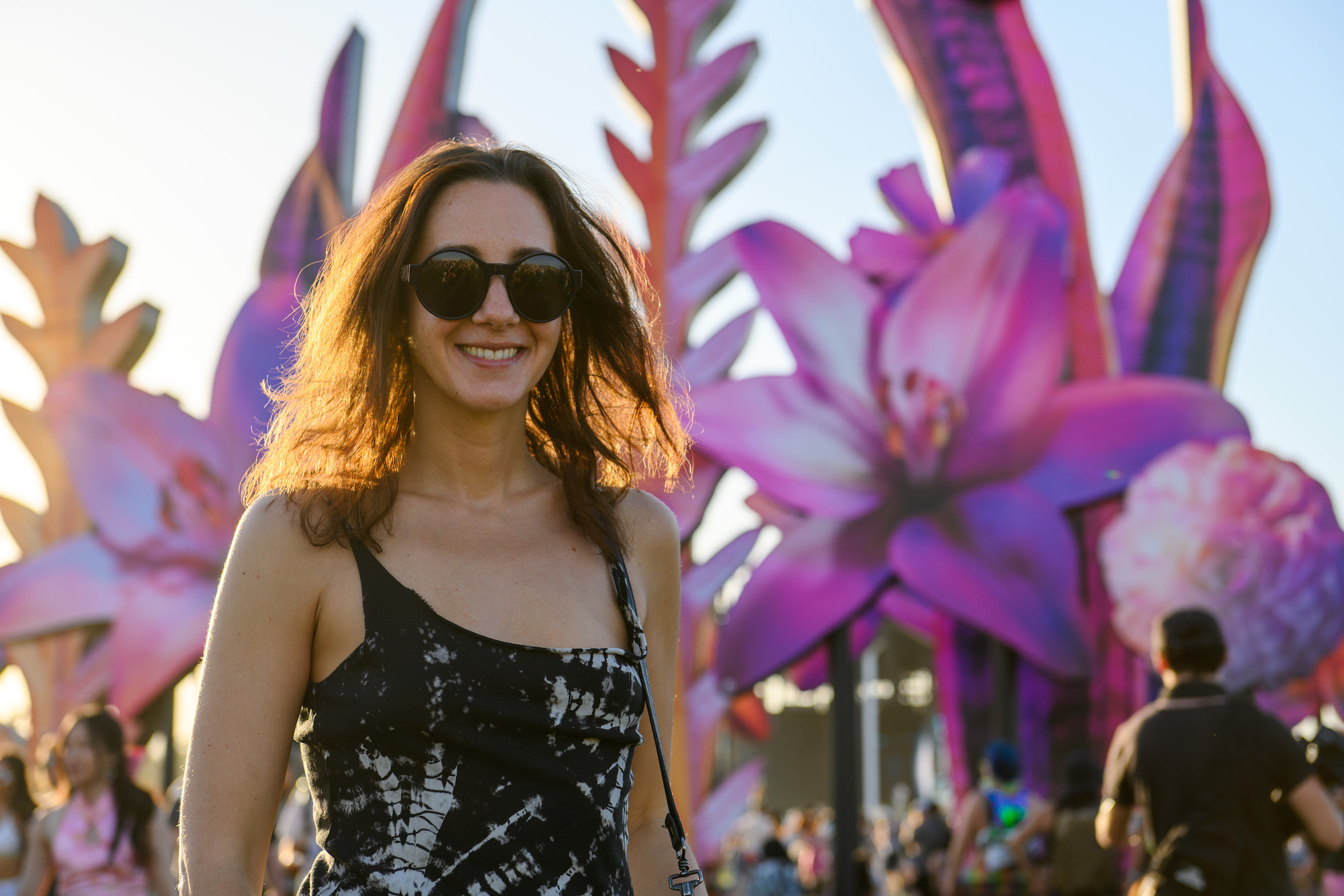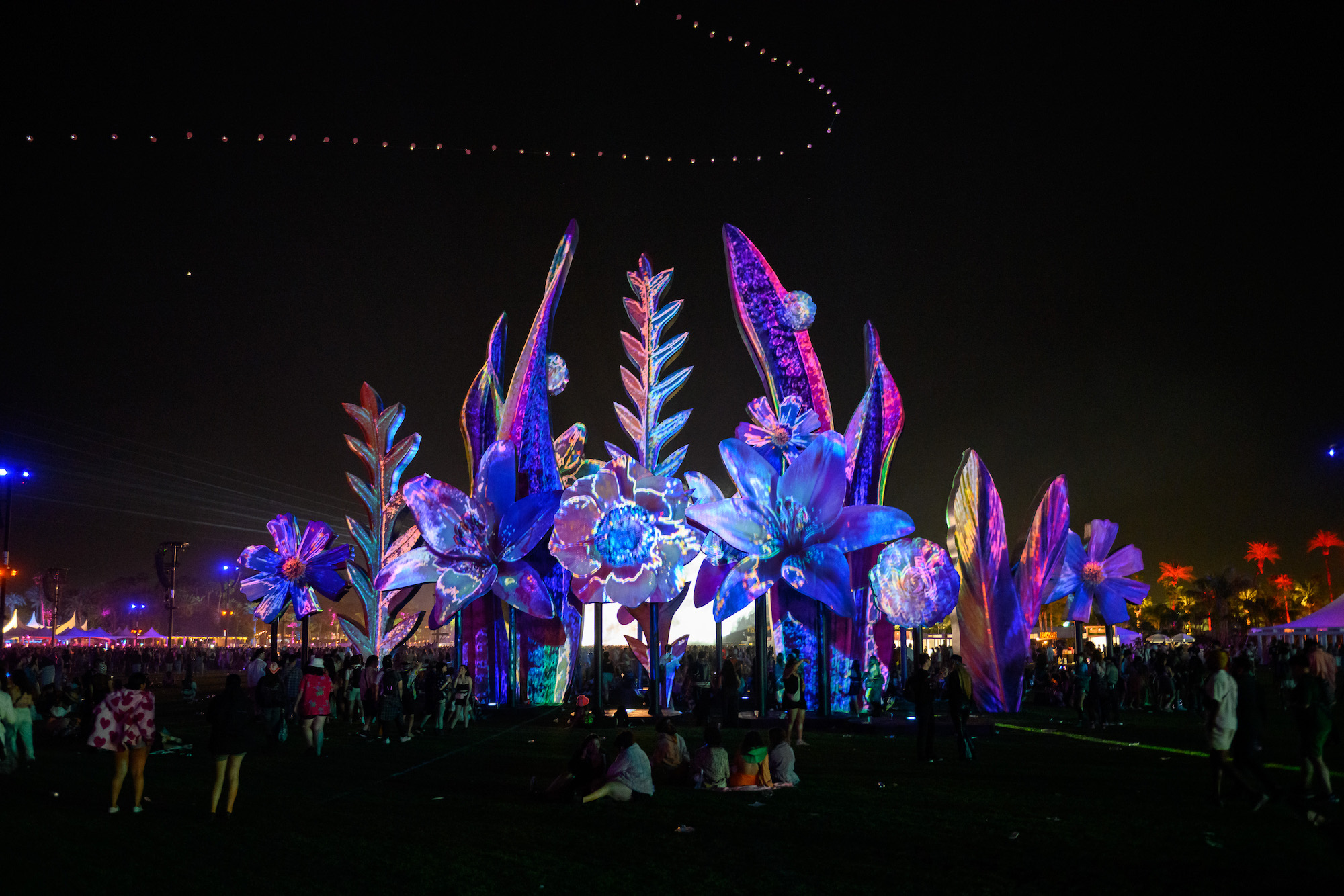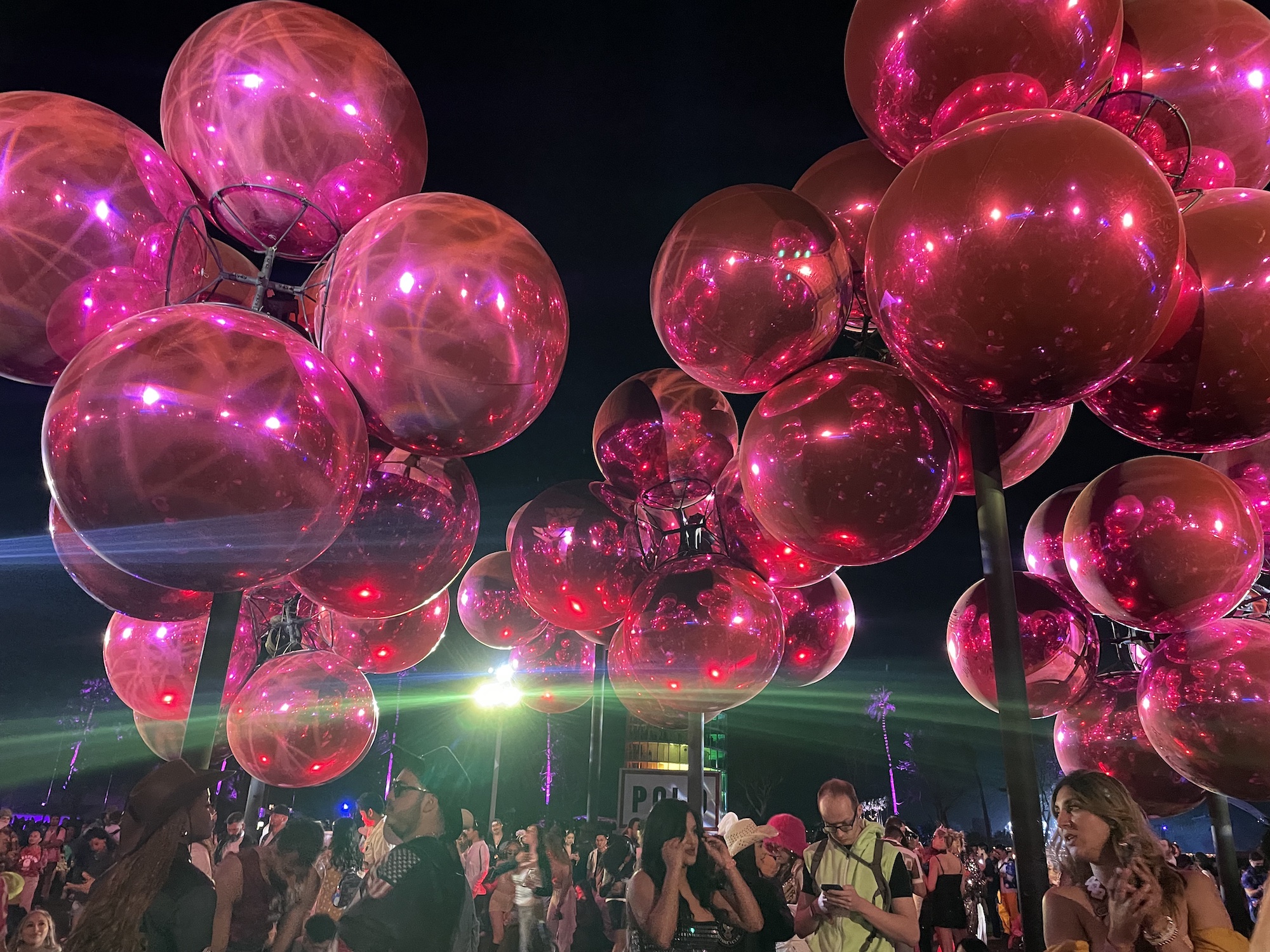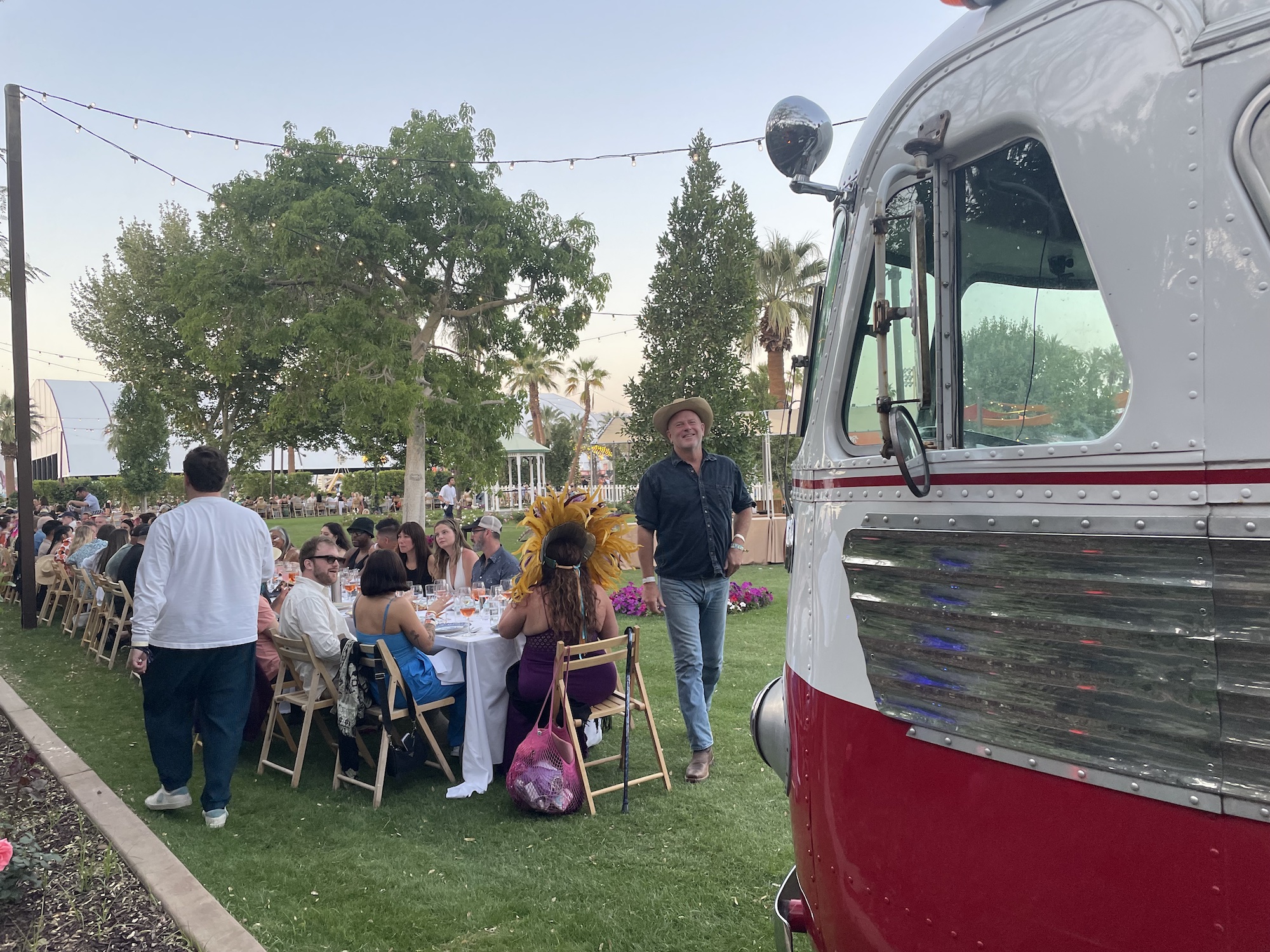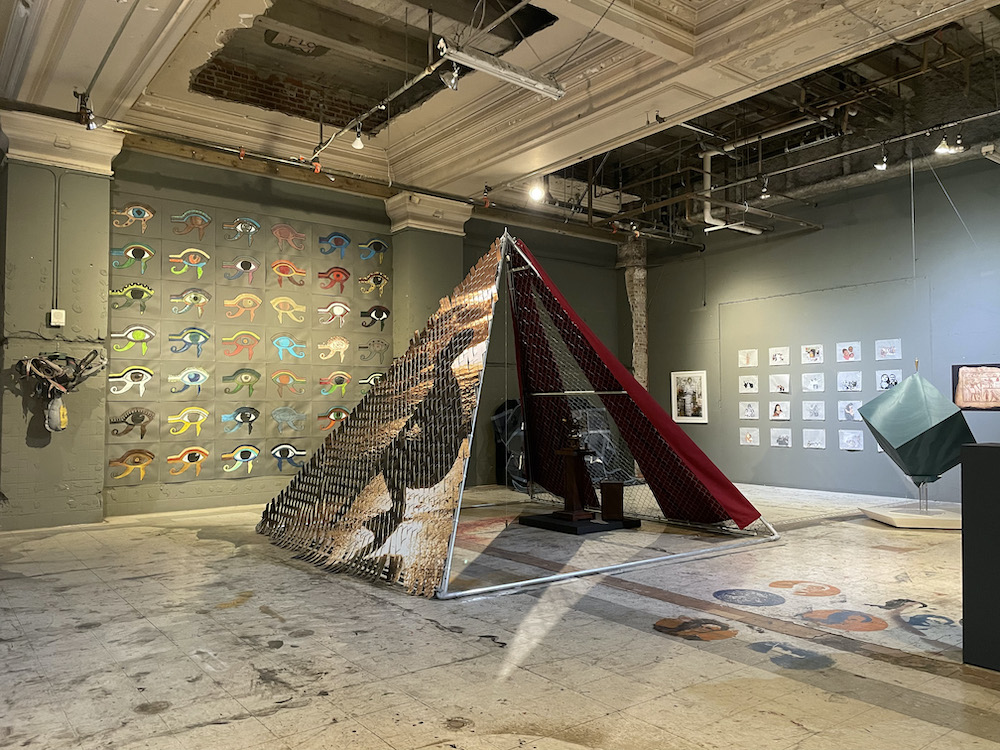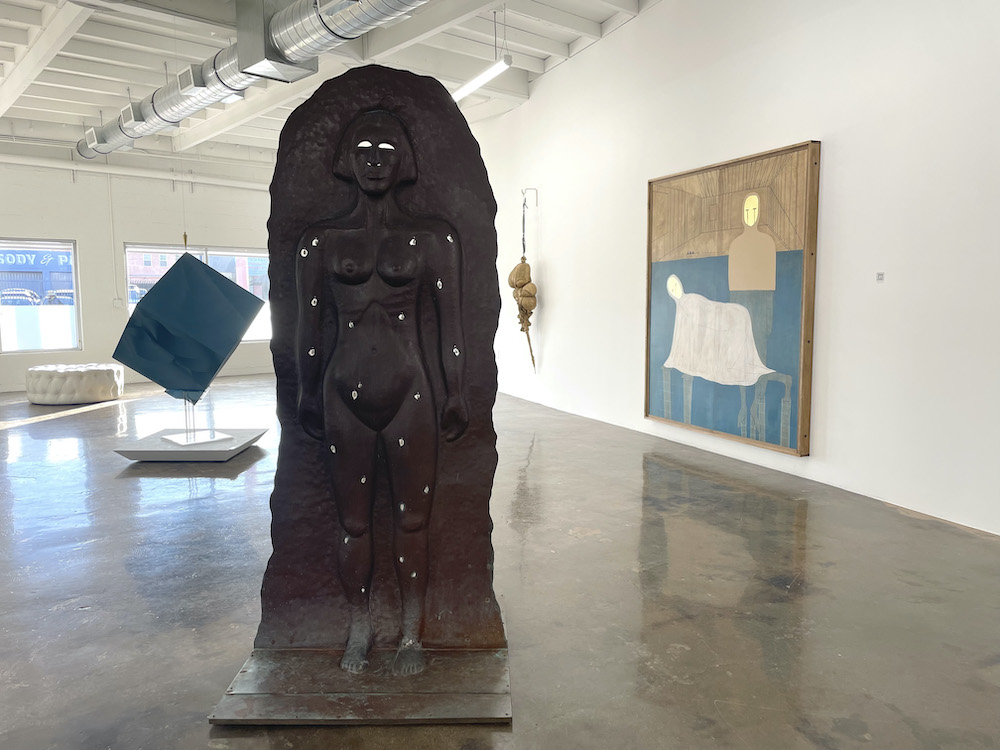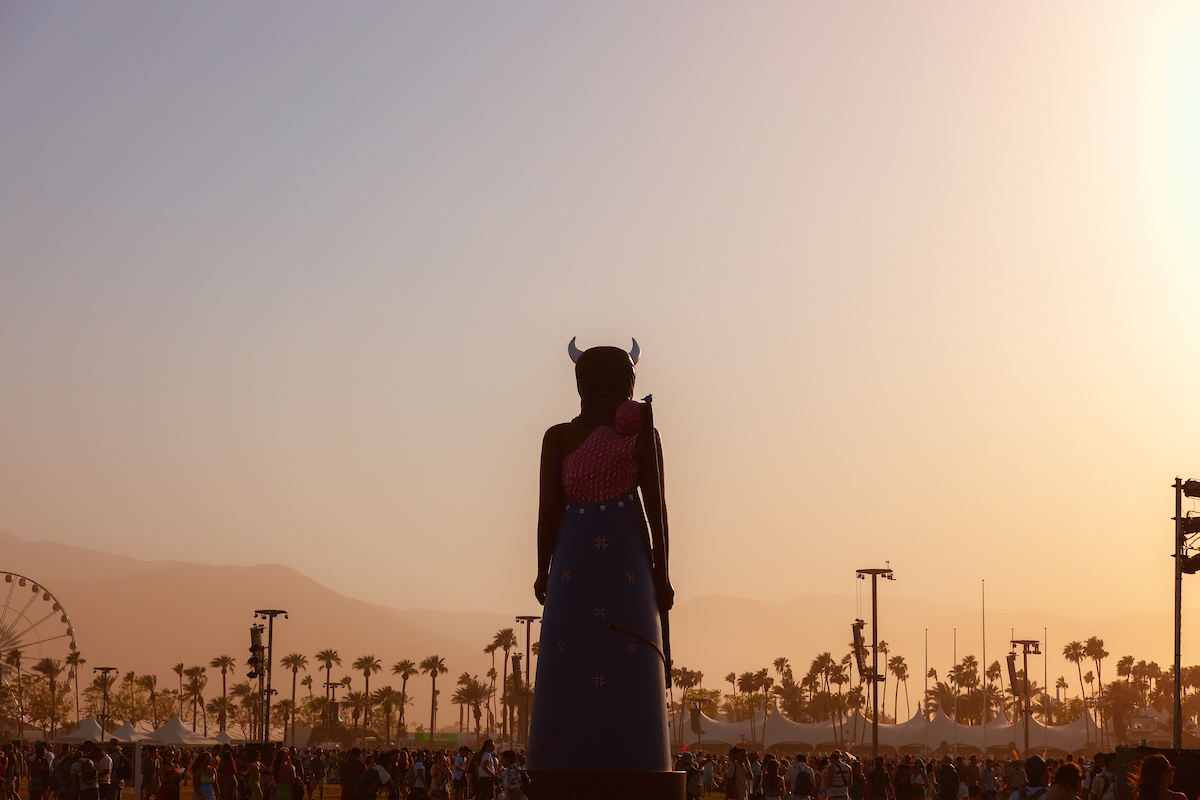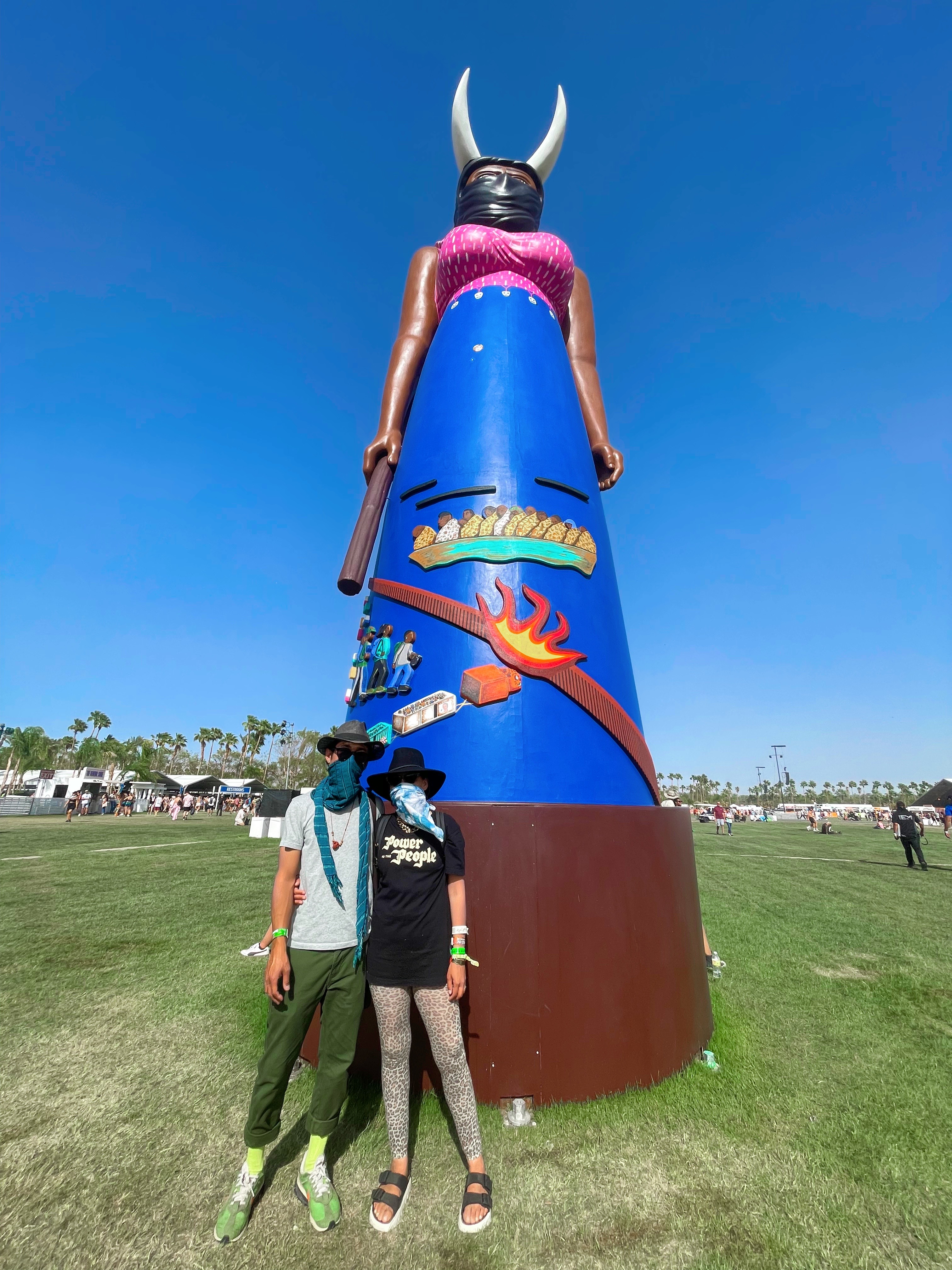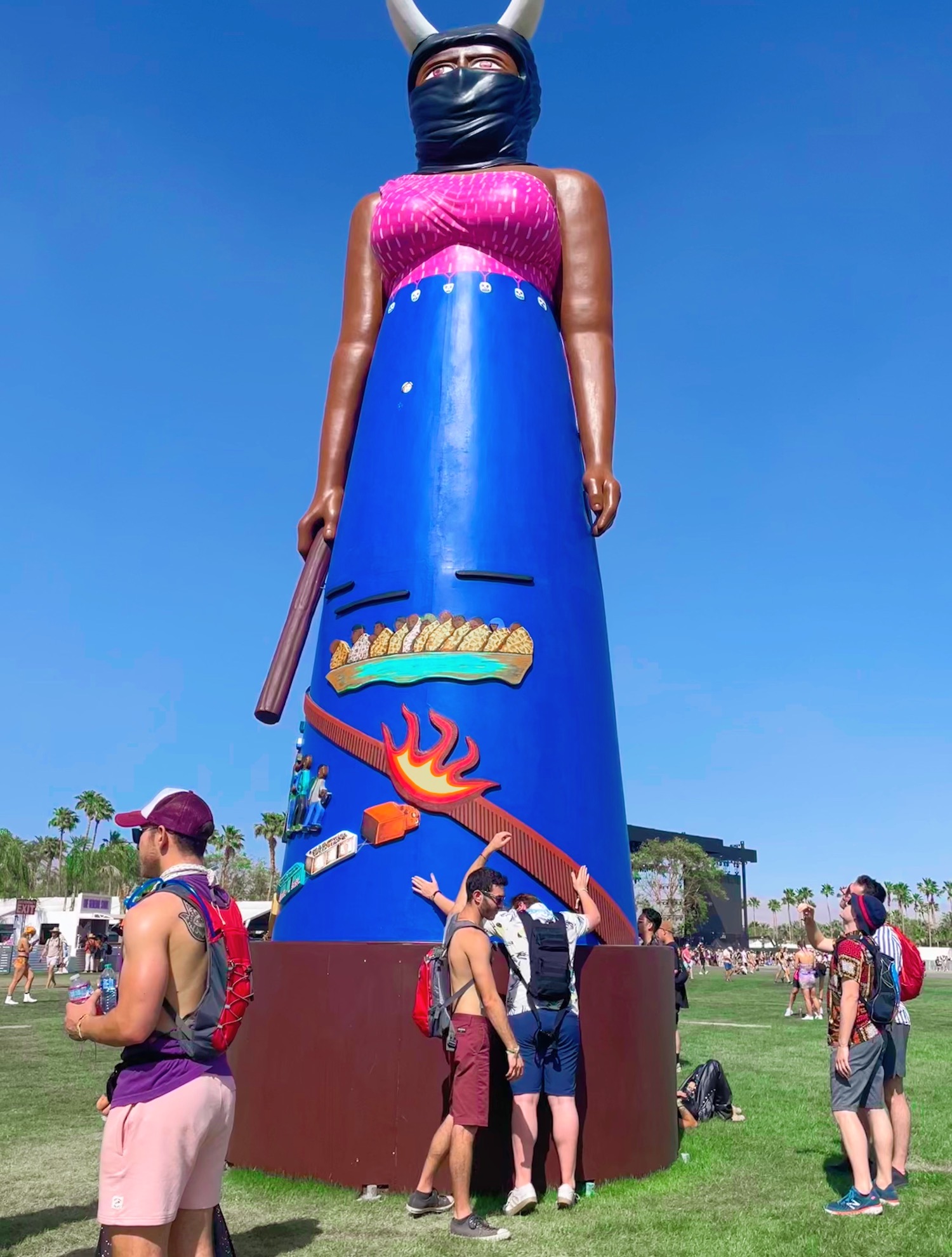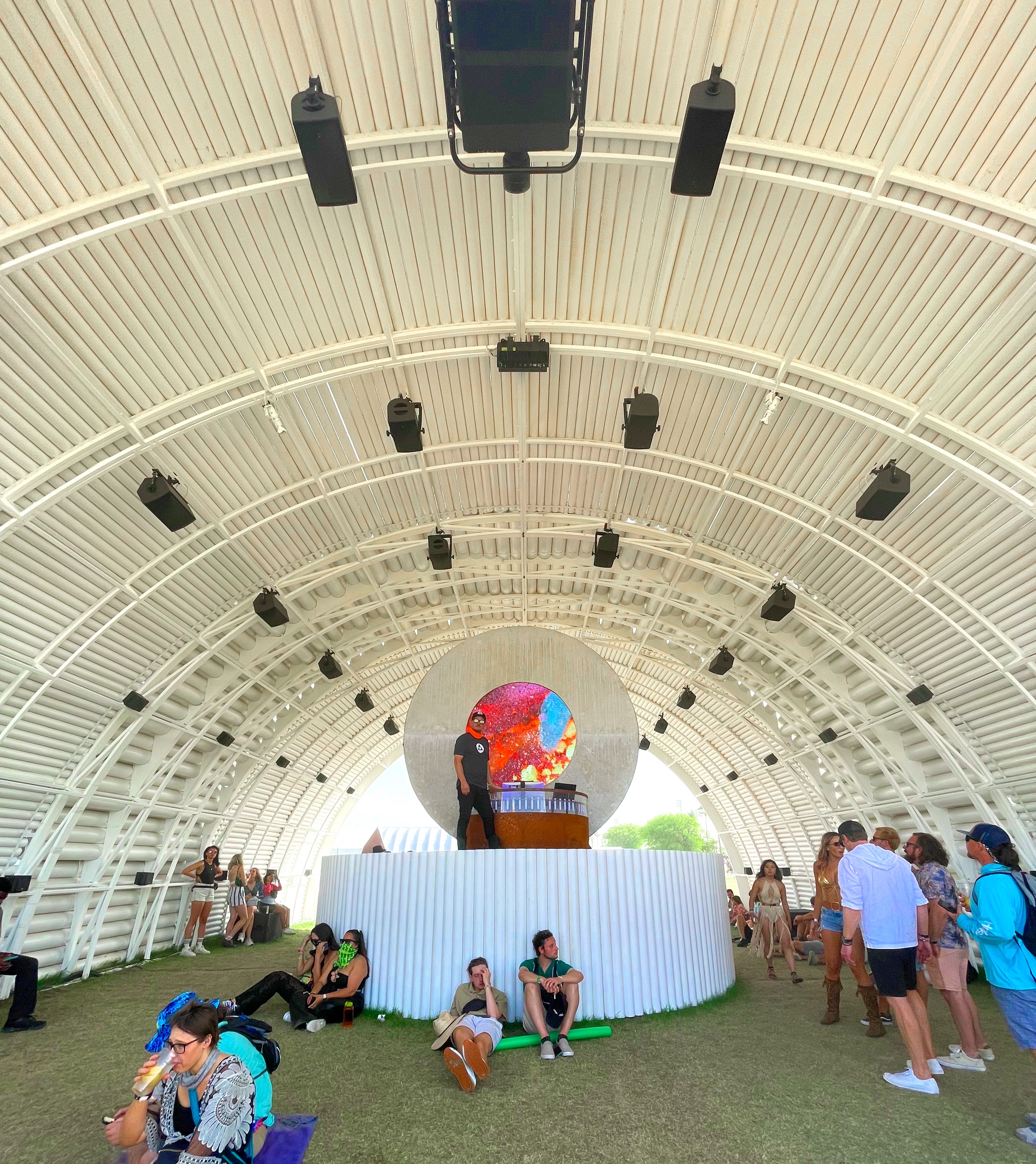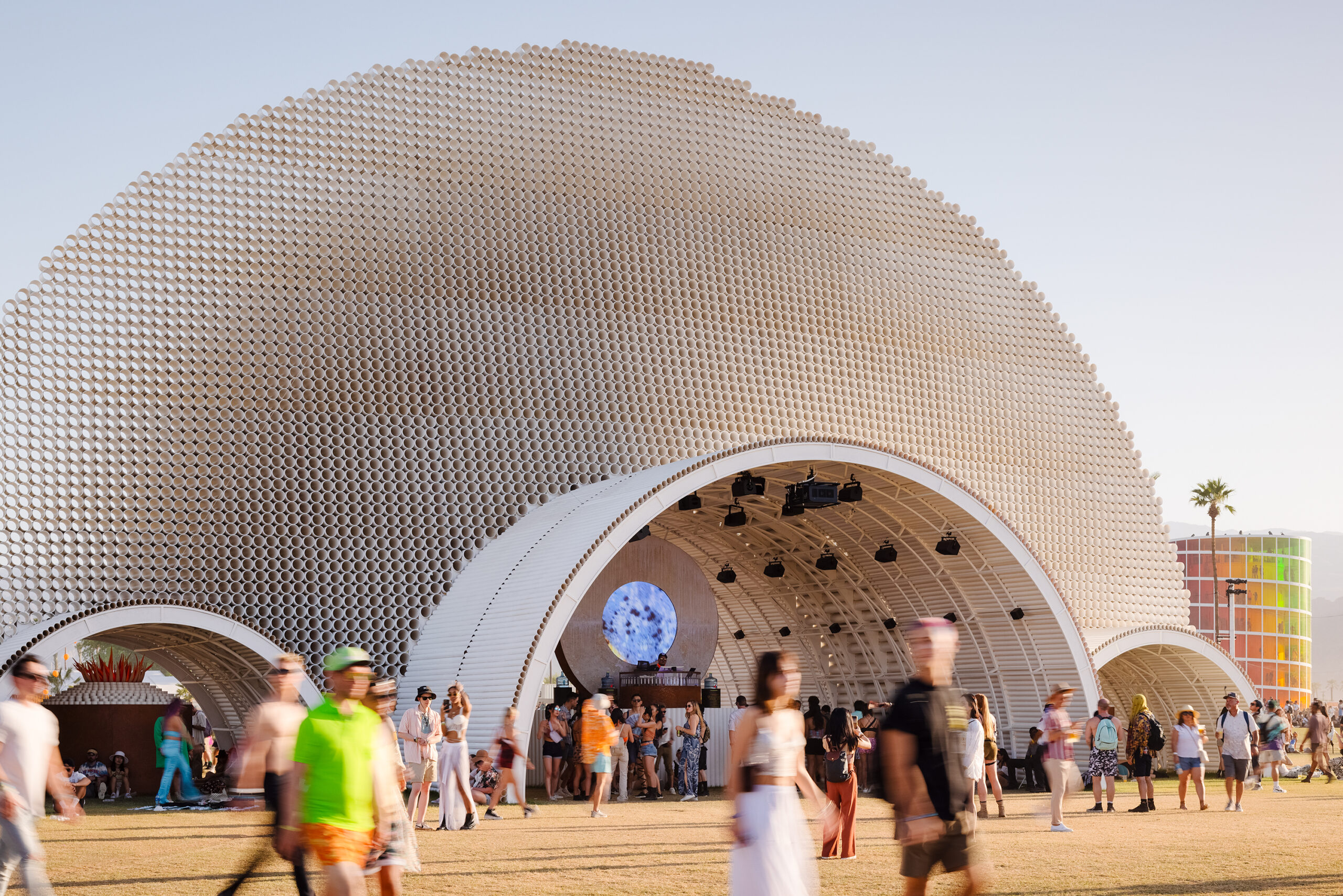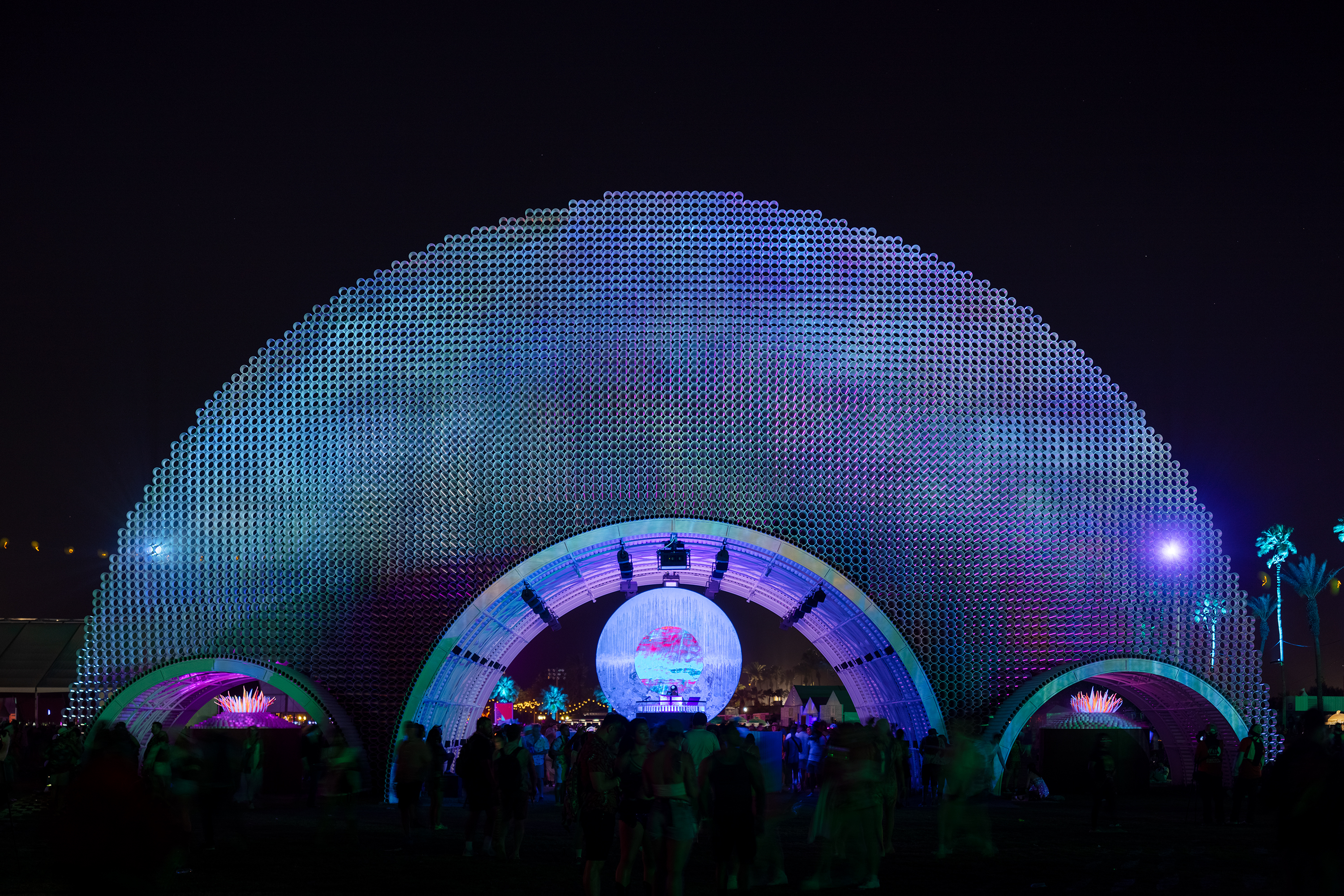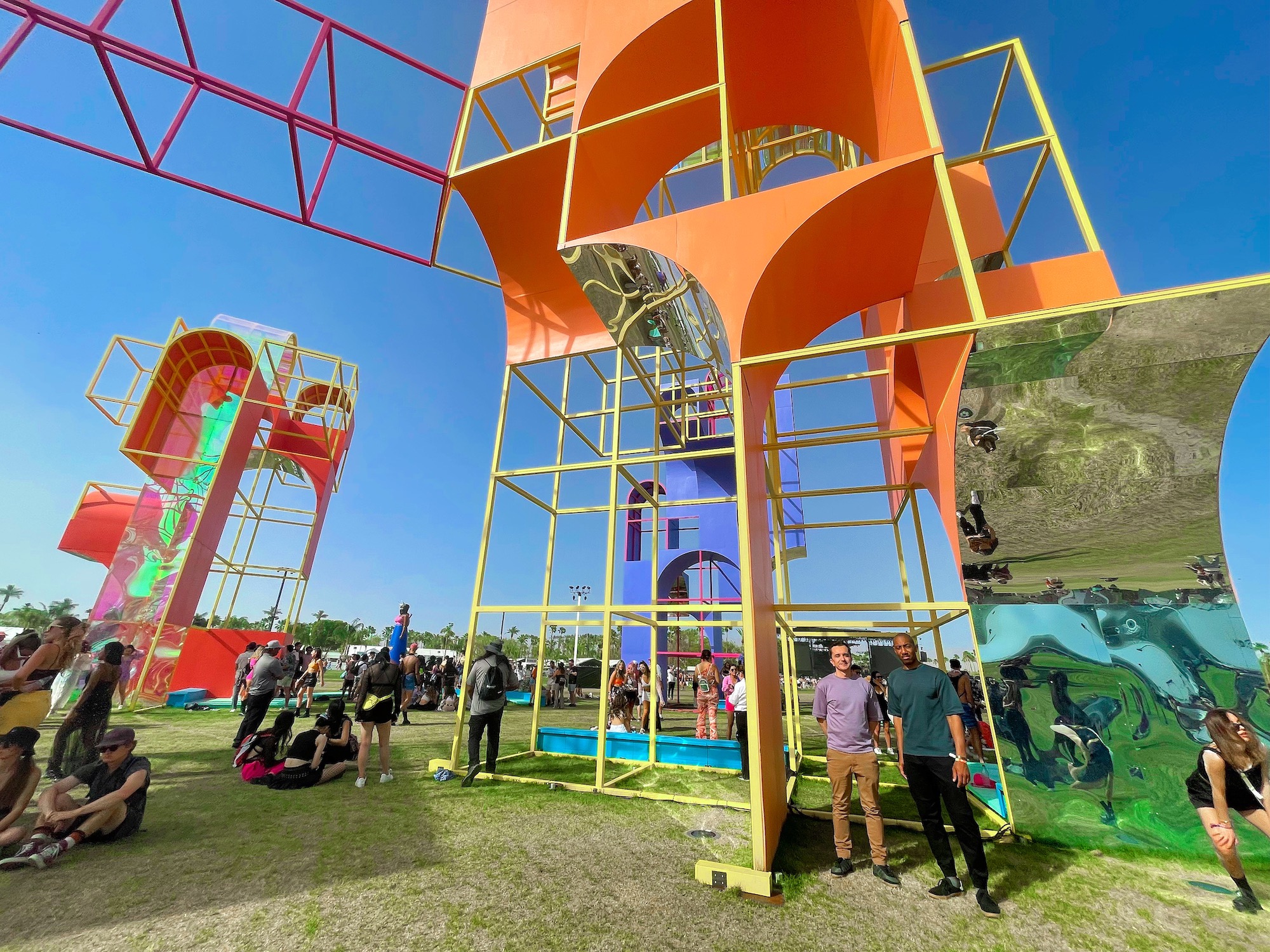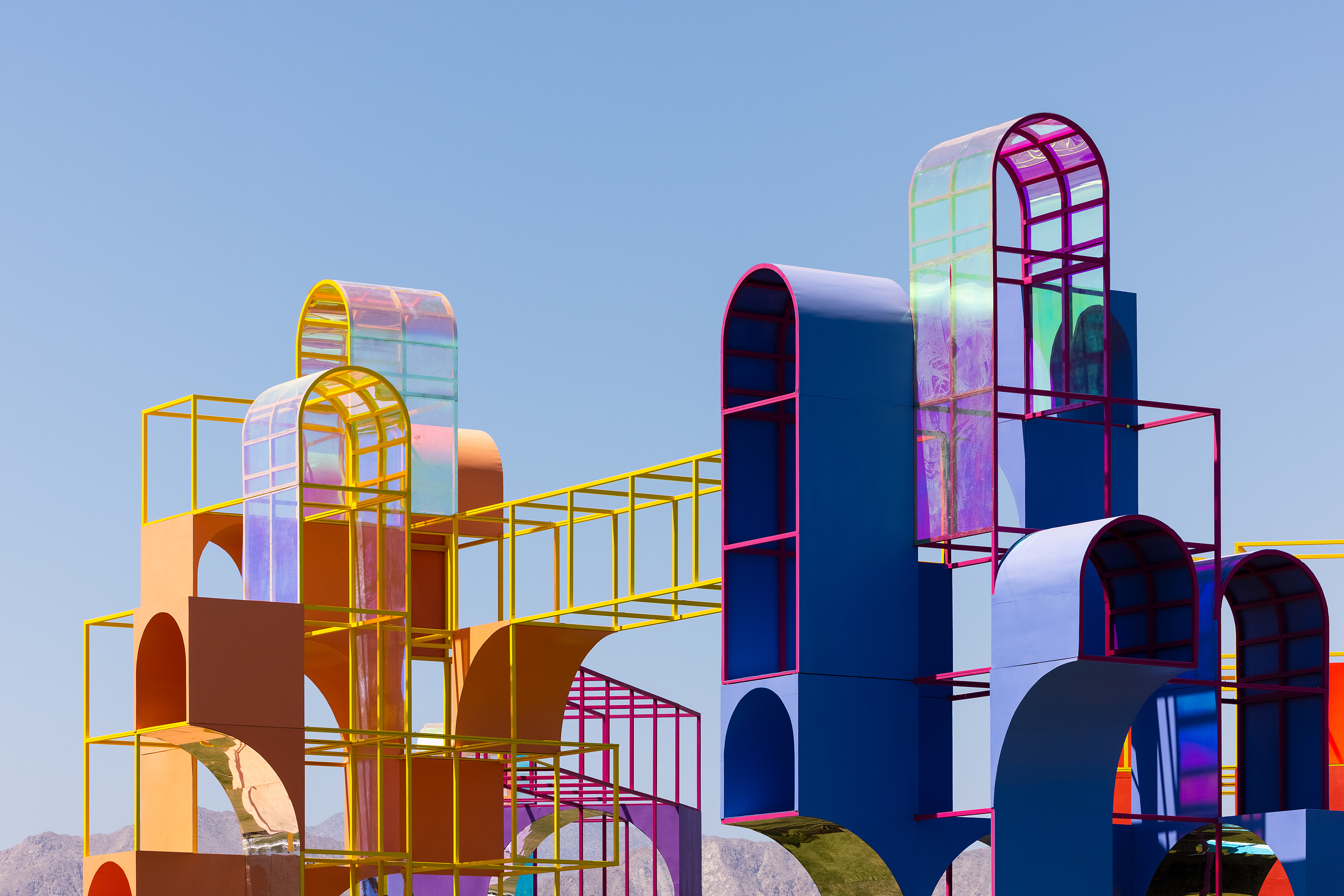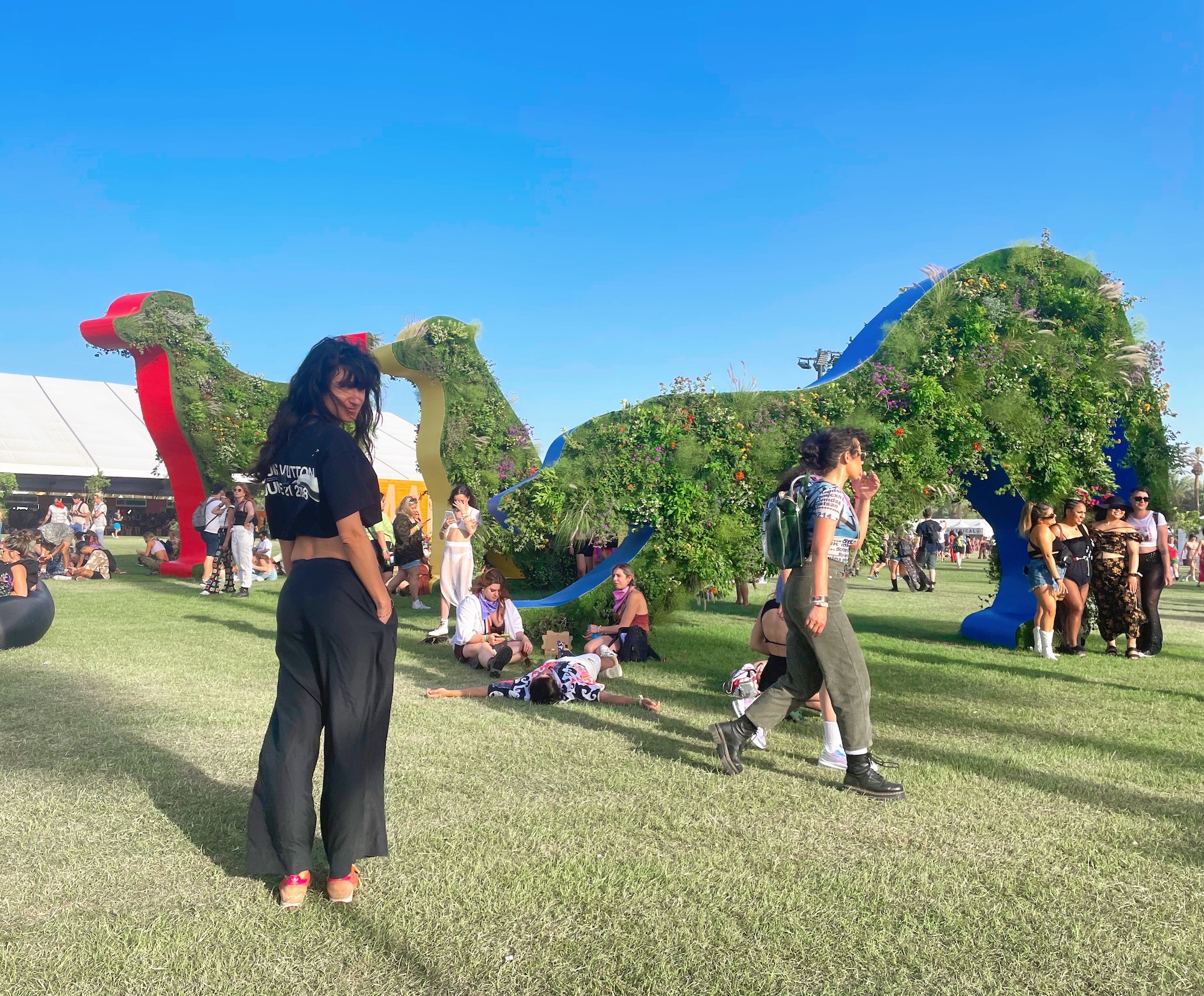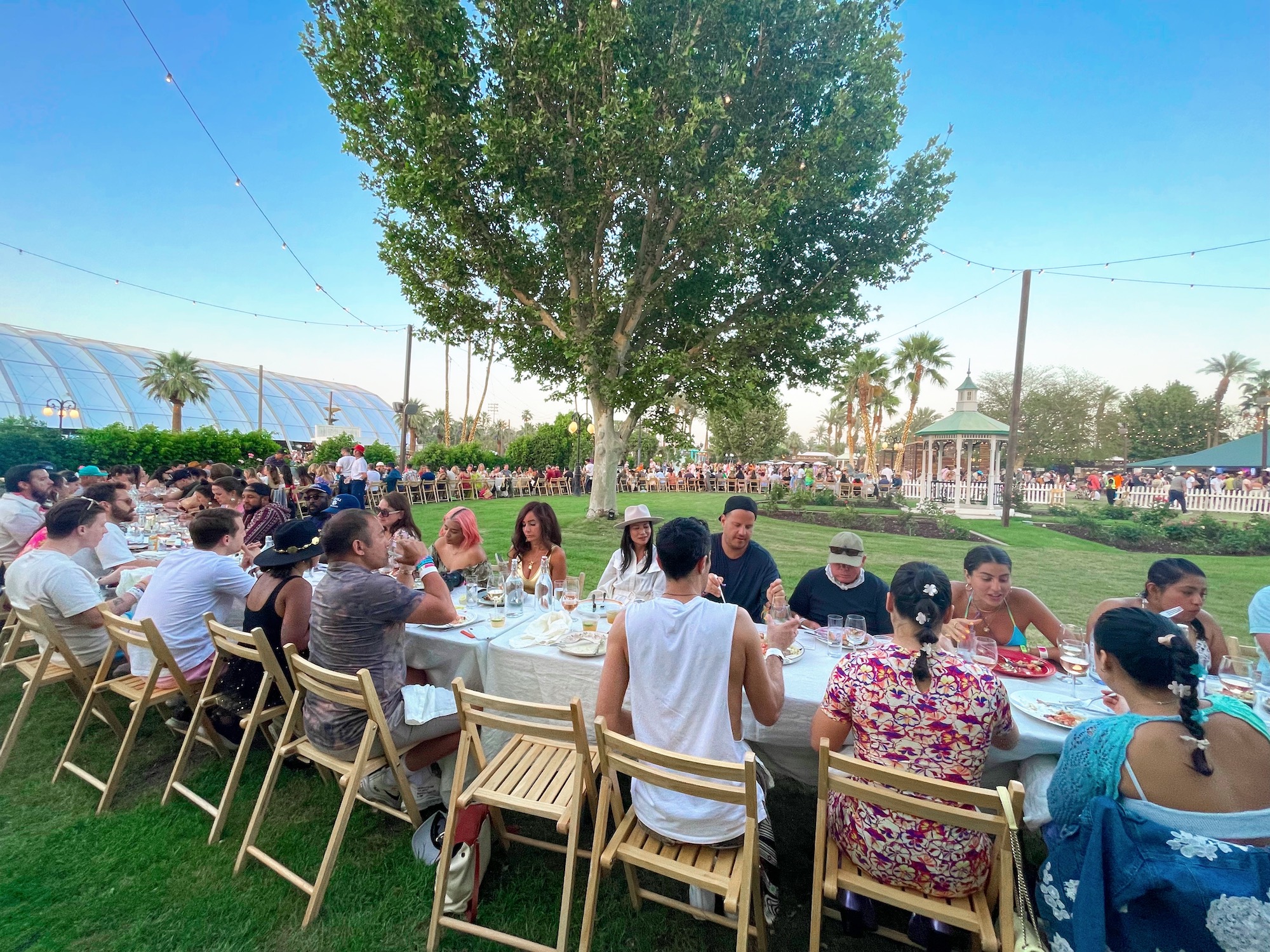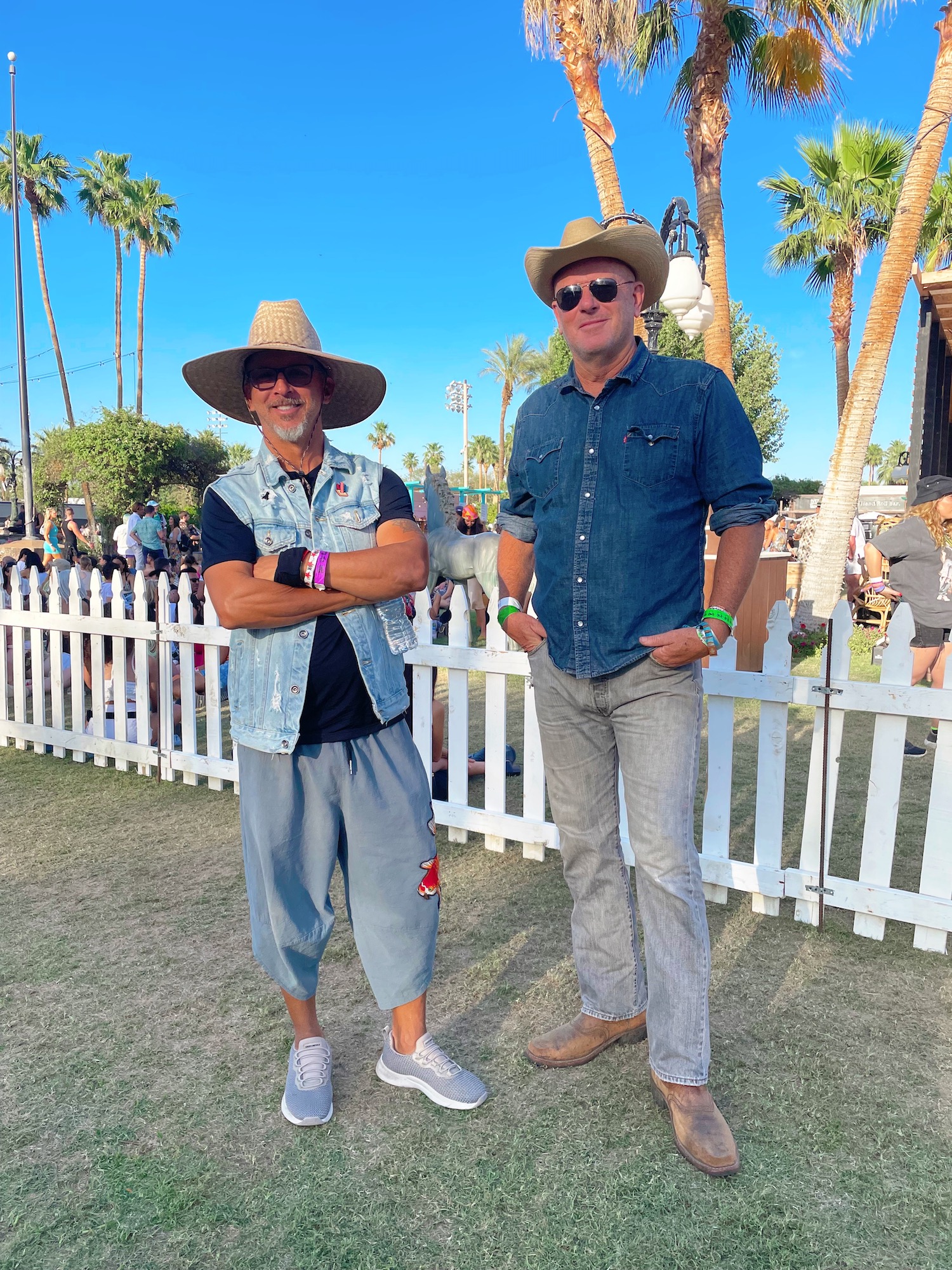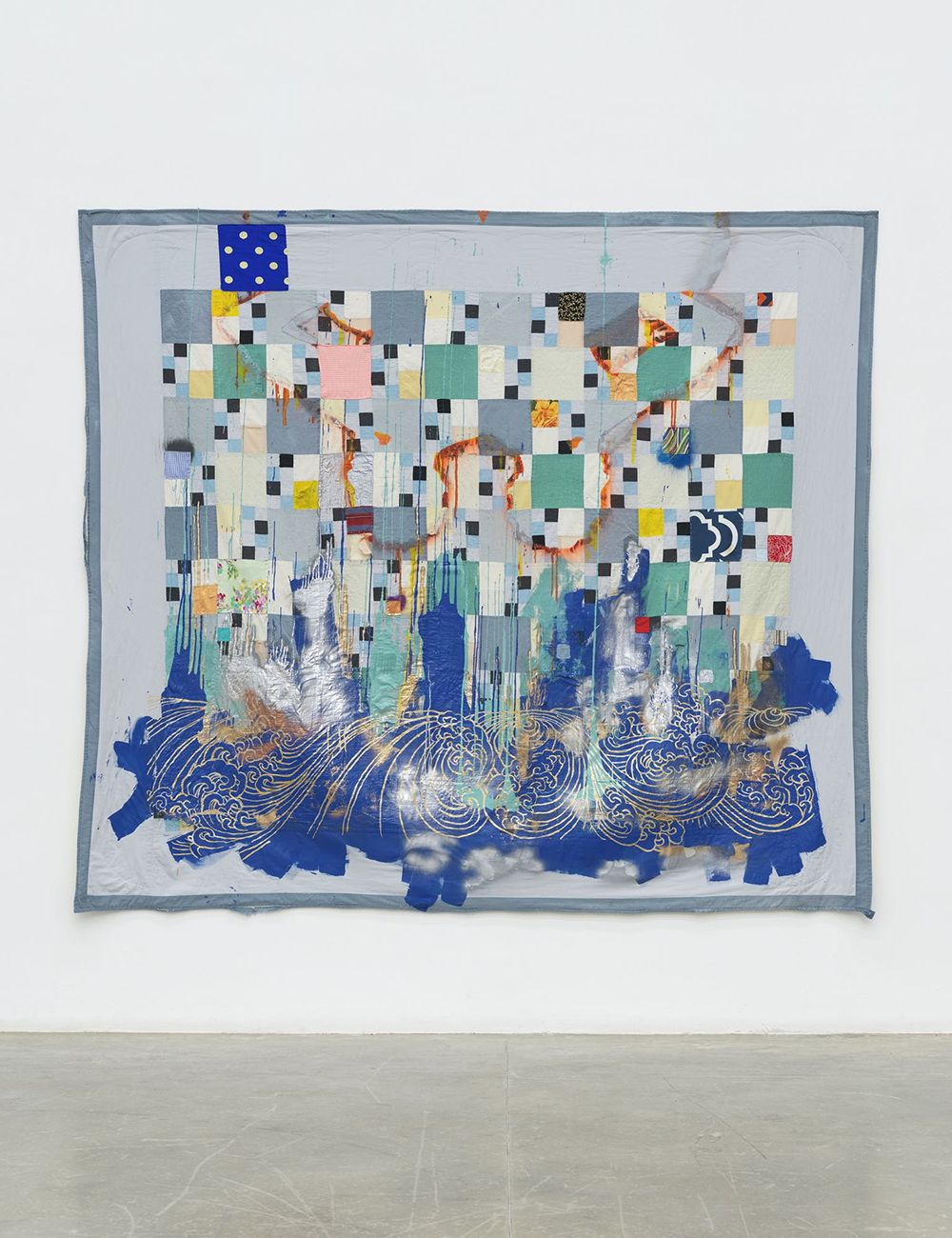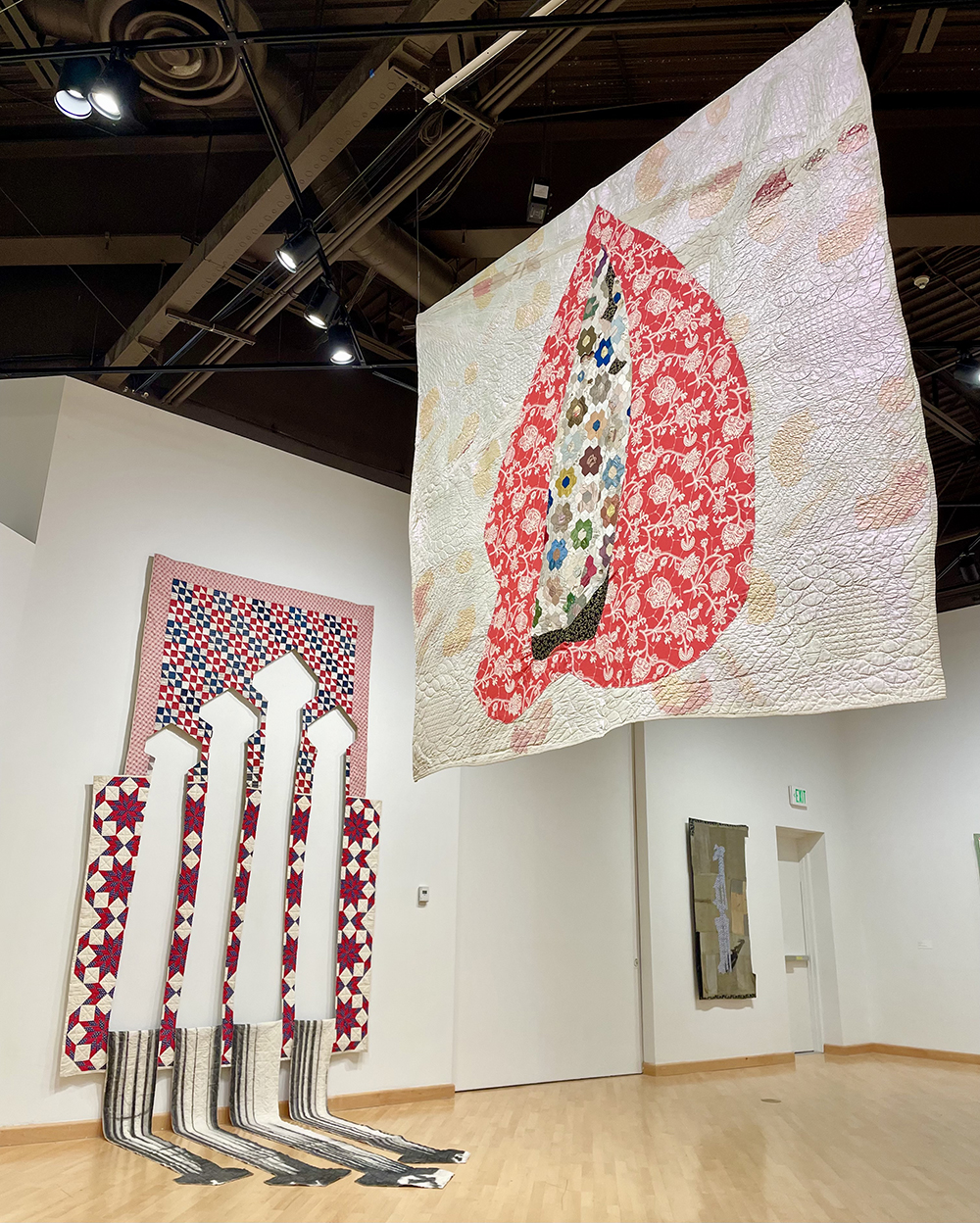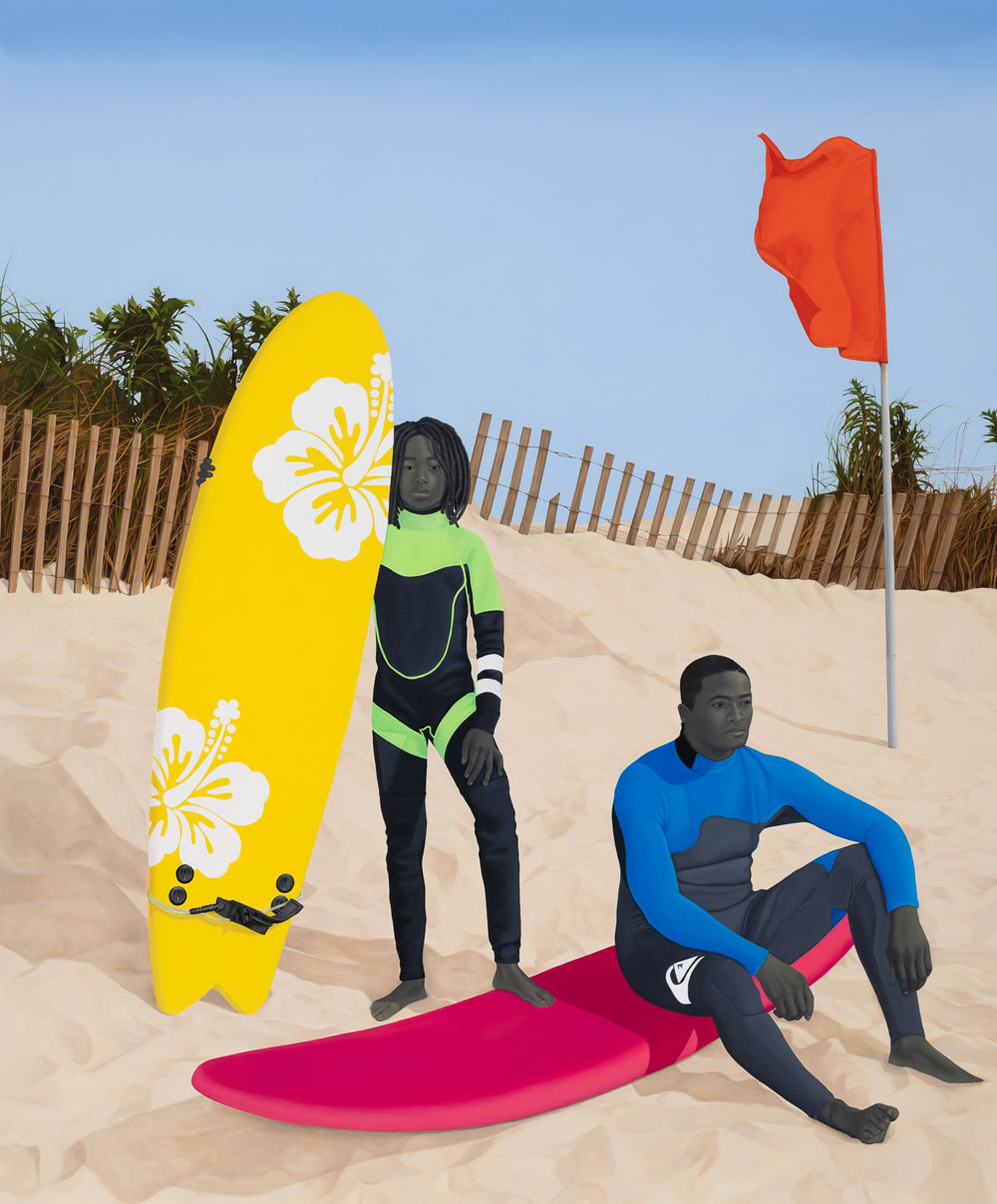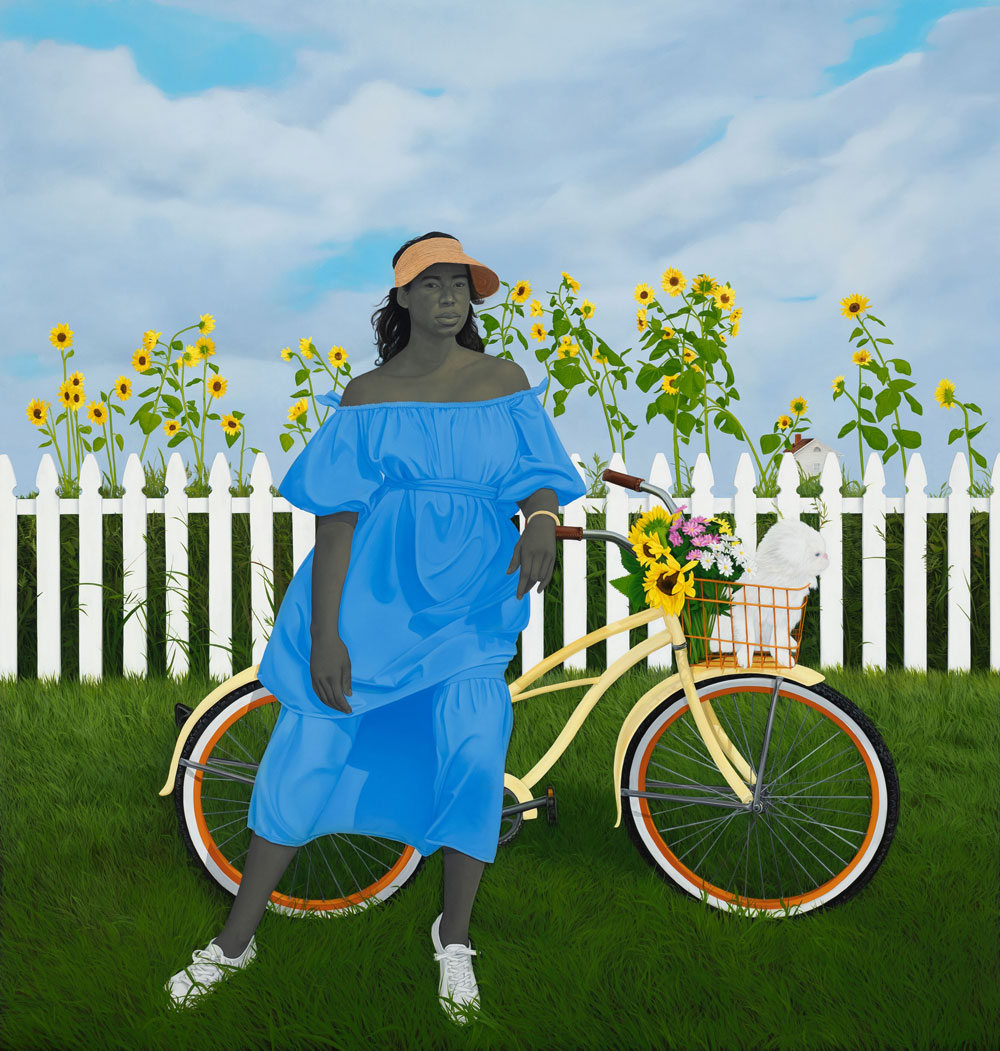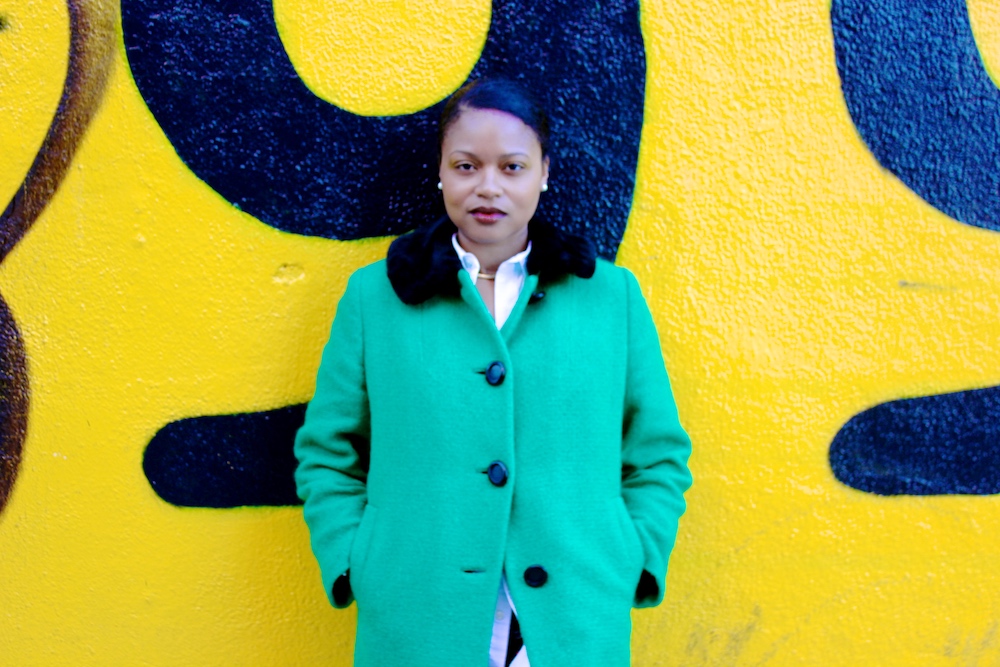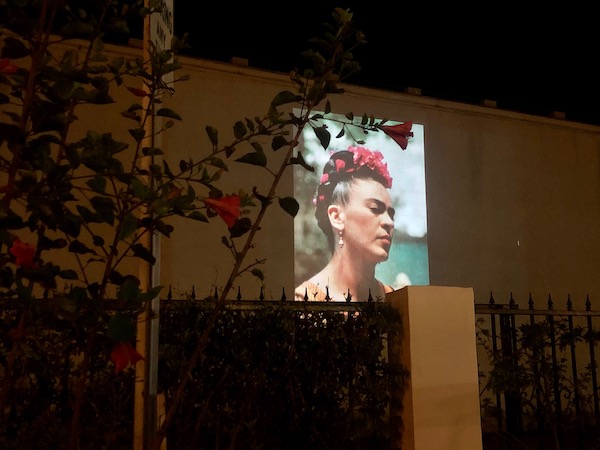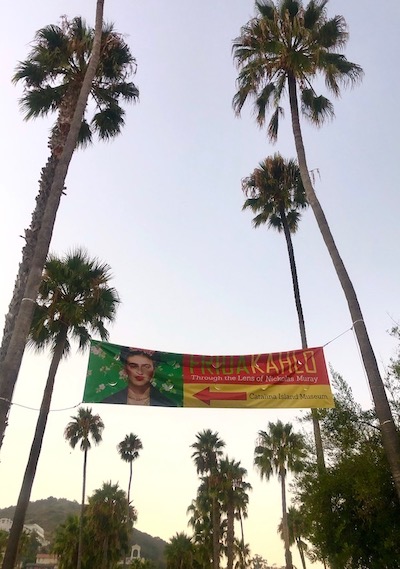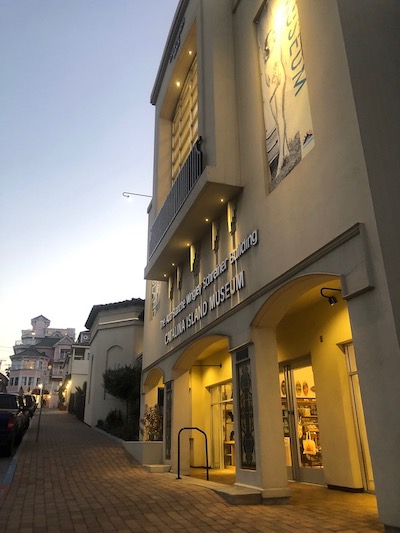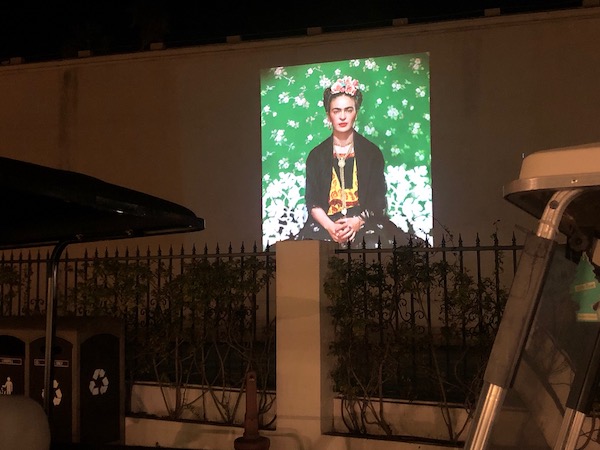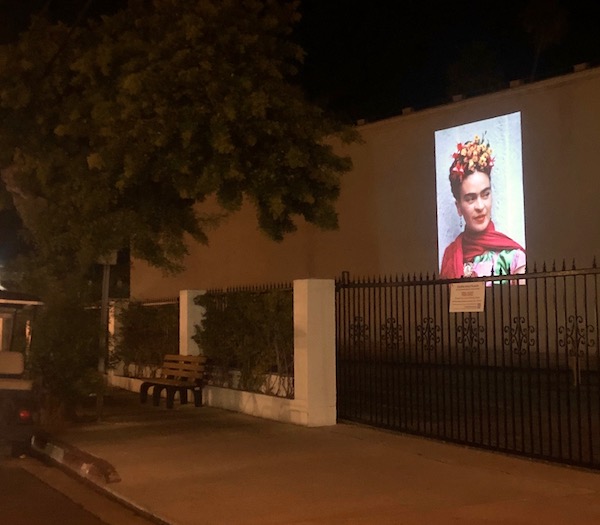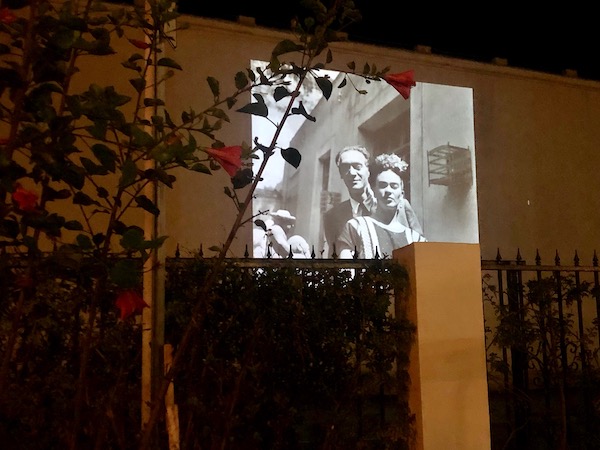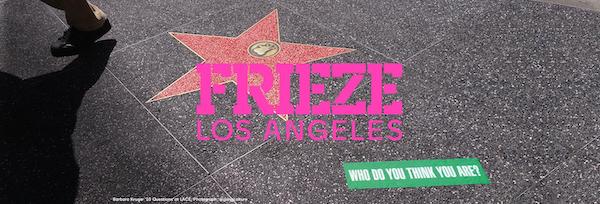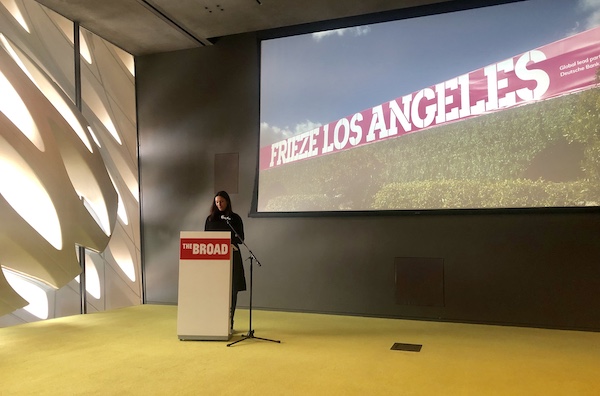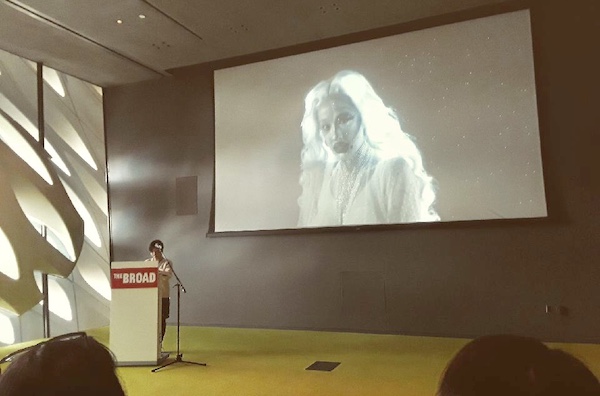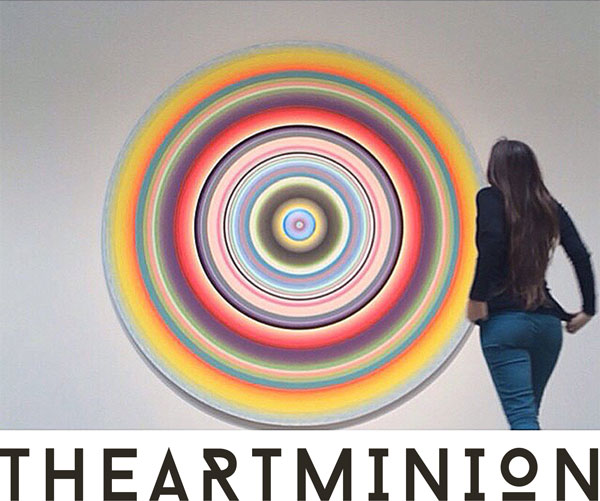Your cart is currently empty!
Byline: Bianca Collins
-

Desert X
Since 2017, I have been among the 1.7 million people who have participated in the art biennial-cum-treasure hunt to seek out large-scale, site-specific contemporary art installations scattered throughout the Coachella Valley desert, the land of the haves and have-nots. Not in a white cube, locked away in a walled institution, or behind a paywall, Desert X is a great equalizer, breaking down the walls of the institution and sharing the cultural wealth of art and the wild west with any who wish to seek it out.
Nestled into the perimeter of the iconic wind farms in Desert Hot Springs, Jose Dávila has installed 12 massive blocks of white marble from a Mexican quarry. Harnessing the illusion of exhilarating precarity, he balances pairs of them upon one another, creating towers and cantilevers of brilliant stone that absorb and bounce the desert sunlight, jutting into your field of vision from every perspective. The monumental presence of these unmissable forms of extracted land provokes a consideration of the counterbalanced emptiness that must exist elsewhere, mirroring the heavy weight of the lived reality of so many immigrant communities in the area but not from the area. The act of being together is beautiful, bold, and somber to behold all at once
In Palm Springs, Ronald Rael’s Adobe Oasis imagines a future where robotics and ancient adobe architecture can effectively answer the housing crisis. His open-air, maze-like structure—meant to evoke the texture of the city’s eponymous palm tree trunks—demonstrates the possibilities of a modern adobe tradition 3D printed in locally sourced and sustainable Corona Clay. I wasn’t delighted by its aesthetic—its walls looked to me more like excrement squeezed through a large icing pipe—but the imaginative underpinnings of the alternative future it proposes won me over. As they say, the future is now. The work provokes critical consideration as entire cities devastated by natural disasters are rethinking how to rebuild in a climate crisis. Rael’s installation reminds us that adobe architecture has stood the test of time and offers a glimmer of hope.

Desert X 2025 installation view of Alison Saar, Soul Service Station. Photo: Lance Gerber. Courtesy of Desert X. I was soothed and amused by the imagined architecture of Alison Saar’s Soul Service Station, a gas station for collective healing. Like a friend who acknowledges our troubles and reminds us that we are stronger than any moment of seeming defeat, all who encounter it are invited to refill our troubled, deflated souls with optimistic energy. Its attendant, Ruby, is fashioned in Saar’s signature figurative style, carved from sturdy wood and covered in an armor of salvaged ceiling tin. I felt her protective energy washing over me as words of encouragement by poet Harryette Mullen poured out of the gas pump’s two conch shell-shaped nozzles. The experience felt like a warm hug, gently asking me to slow down and absorb the multitudes of Saar’s layered assemblage sculpture, radiating with the inherent magic of reclaimed materials that carry their own histories of resilience.
Agnes Denes’ The Living Pyramid at the historic Sunnylands Center & Gardens is a durational work covered with flora planted last November. The multi-story living sculpture, a brilliant white stepped pyramid garden bed, is a commanding centerpiece of the already impressively manicured gardens. When I visited it during the press preview in early March, set against the distant snow-covered mountaintops, the sculpture was covered in plants boasting the vibrant greens, pinks, yellows, and oranges of early spring. But everyone who visits will have a different experience as the plants continue to bloom over the course of the installation. When the snow inevitably melts, and the pyramid is in full bloom, the relationship to its site will change, and the aesthetic harmony I experienced will be replaced by the juxtaposition of a fragile garden thriving in the heart of the desert.

Desert X 2025 installation view of Agnes Denes The Living Pyramid at Sunnylands Center & Gardens. Photo: Lance Gerber. Courtesy of Desert X. The impact of Saudi artist Muhannad Shono’s immersive installation What Remains, more so than any other project this year, doesn’t translate to 2D. Images of the work meant to pique my interest enough to pull me out into the middle of Thousand Palms seemed to promise little more than large trash bags blowing in the wind, and the artwork’s highfalutin didactic promising “a state of tremor,” had me rolling my eyes. But my experience of this anti-monument demanded quiet contemplation as I stood observing a field of —yes, rolls of trash bag-like material painted and covered in sand—malleable forms taking on the undulations and palette of the barren landscape. With only the sounds of its fabric scratching against dry desert brush in the wind breaking the silence, it felt eerily like I was at the end of the world, in a future when the last of us who had survived in tents were no longer around to maintain any semblance of home. Is this what is destined to become of us? Is this a fixed destiny, or something that can be interrupted? Is there justice and beauty in ruin? I reluctantly left after 30 minutes of observing the work as it transformed with every breeze, moving through it in quiet contemplation as my perspective of the landscape and possible answers to my existential questions changed with every step.
In today’s world of rapidly accumulating crises, I suppose it’s no surprise these installations captured my heart with their abstracted pedagogies of hope, a welcome reward for finding where X marked the spot.
Desert X 2025
Coachella Valley, California
On view through May 11, 2025 -

Nadya Tolokonnikova
at Honor FraserNadya Tolokonnikova, the exiled Siberian performer and conceptual artist infamous for her Pussy Riot anti-authoritarian protest disruptions in Moscow—whose Putin’s Ashes artworks landed her on Russia’s most wanted list—has found a home away from home at Honor Fraser Gallery in Los Angeles.
“PUNK’S NOT DEAD PART 1” was a short-term performance-based gallery intervention that turned the space into a punk nightclub––or a horror film––complete with a riotous, dissonant, and deafening band wearing a new version of the pink Pussy Riot ski mask—now in white, with black spray-painted Xs over the eyes. Riot gear as wall sculpture, red light filling the room, chain-link fences adorned with ribbons, and large canvases with the word “punk” written in metallic over and over to create the image of barbed wire, set the scene: we are not free.
Unmasked and dressed like a rebellious Orthodox Christian in a white robe with a large crucifix hanging around her neck (and Converse on her feet), Tolokonnikova oscillated between live destruction of the metal riot shields with Christian ephemera, screaming into the mic only to be drowned out by the band performing alongside her, and twirling her long black hair like a provocative and possessed porcelain doll playing innocent.
How loud must she scream into the void to make a difference? How can she grab and keep our attention? Can a punk rebellion ever really be silenced?
Hell if I know. I was entirely uncomfortable during the unruly, ear-splitting, and chaotic performance––admittedly, for the same reasons, my punk phase as a teen was short-lived and never returned to. But, isn’t this precisely what punk is designed to do: to make us uncomfortable, to shake and shock us out of our complacency and into resistance? Perhaps my discomfort was the whole point. Perhaps it qualifies as a win.
Although I walked away with a lingering sour taste in my mouth, I have to respect the way Tolokonnikova moves through the world: defiantly. I’ll tune in for “PART 2” this Spring, when I hope to get some answers from her new body of visual artworks—where I believe Tolokonnikova shines the most and cuts through the noise.
-

Barbara Carrasco
at the Natural History Museums of Los AngelesThe Queen of Los Angeles will not allow her history to be erased, and neither will Barbara Carrasco’s 1981 mural L.A. History: A Mexican Perspective. Censored swiftly after its completion by the commissioners, the mural collected dust in storage for decades and is finally on permanent public view at the Natural History Museums of Los Angeles County.
Why does this matter? We all deserve to have our stories told.
A cacophony of imperative Los Angeles histories find their proper place in Carrasco’s visual chronology, the darkest of which are not easily found in textbooks. Woven into long strands of La Reina’s brown hair are painted scenes from when cacti ruled the land through Indigeneity to the violence of colonization and enslavement and the eventual victories of heroes like Biddy Mason, who broke those chains for themselves and others. Oft-forgotten seminal moments fill vignettes, like the 1871 massacre mob-lynching of 22 Chinese men and boys, the Zoot Suit riots of 1943, and the horror of Japanese internment camps.
The epic mural is a crown jewel in the new NHM Commons wing, free and open to the public daily. Despite being silenced over 40 years ago, Carrasco and her mural are here to stay – and that, amigos, is poetic justice.
-

ABOLITION IN ACTION
Crenshaw Dairy Mart Cares About People[et_pb_section admin_label=”section”] [et_pb_row admin_label=”row”] [et_pb_column type=”4_4″][et_pb_text admin_label=”Text”]The artist-of-color-led arts organization and collective in Inglewood, Crenshaw Dairy Mart (CDM), is continuing a legacy of Black-led art spaces in South Los Angeles. Co-founded by multi-hyphenate artists Patrisse Cullors, alexandre ali reza dorriz and noé olivas, it has been operating largely under the radar since its inception in 2020. As the kids say, “If you know, you know.”
The art world’s awareness of CDM, its mission and programming—all orbiting around the radical concept of abolitionist aesthetics, defined by Cullors and dorriz in a UCLA Law Review paper as the “contemporary artistic movement where artists, collectives and organizations have employed the arts to address abolition of the prison-industrial complex toward an effective social and political change”—has been a slow burn.
But, after successfully self-advocating to be included in the third iteration of the Getty Foundation’s epic PST art program, CDM is officially a pre-
vetted, card-carrying contributor to the “in-the-know” art world. I spoke over the phone with dorriz, olivas and Programming Director Vic Quintanar, to learn more about their program.The two prongs of the prison-industrial complex abolition movement—or simply, abolition—are the removal of harmful systems and the imagining of alternatives to those systems, such as mutual aid, liberation and rehabilitation. CDM’s exhibition “Free the Land! Free the People!” will present the evolution of abolitionist pod (2021–ongoing): geodesic-domed modular standing-garden installations that reimagine community care and other tenets of abolition, such as the capacity to resist capitalism through autonomy and reconnecting with the earth.
The prototype abolitionist pod was created during the height of the COVID-19 lockdown, when hospitalizations and food insecurity were at record highs. The co-founders saw an opportunity to imagine a new way forward. “What would this have looked like if we lived in abolitionist mainframe?” said dorriz.

Crenshaw Dairy Mart abolitionist pod (prototype) Drawings and Digital Renderings, 2021. Courtesy of the Crenshaw Dairy Mart. When The Museum of Contemporary Art (MOCA) invited CDM to be its partner for the 2021 “We Rise” project focusing on mental health, the CDM team began brainstorming how to manifest the tenets of abolition visually and engage community meaningfully and safely. How could they leverage abolitionist aesthetics to counter a food apartheid that, noted dorriz, already “existed in the ether and was exacerbated by the pandemic, by systems within capitalism?” More importantly, how would they convince the museum to provide security trained to de-escalate, rather than calling in the police? “MOCA was concerned about people climbing or damaging” the abolitionist pod (prototype) (2021) during episodes of mental illness, recalls olivas, as the pod would be installed publicly outside MOCA Geffen. They said, “‘We’ll need to call the LAPD.’ We were like, ‘No, the structure doesn’t matter, we care about people.’” CDM included language in their agreement with MOCA that they would hire their own security. “I wouldn’t even call them security, I would call them caretakers, to be honest,” said olivas. And thus, an abolitionist security template for future partnerships was established.
Olivas, who has a background in architecture, took the lead in designing the prototype pod, inspired by R. Buckminster Fuller’s seminal dome design and the ’90s film Bio-Dome. The pod was made with such natural materials as bamboo and hemp planter bags. “It was a 20-foot-in-diameter community fridge,” dorriz told me, that featured yoga, meditation, plant swaps and fireside chats.
The prototype pod’s materials had room for improvement, and a second pod was designed with more durable yet sustainable resources to be permanently installed at the Hilda L. Solis Care First Village. The property in downtown LA, “in the shadow” of Men’s Central Jail, was originally acquired to expand the jail. But community organizers and LA County Board of Supervisors Chair Hilda L. Solis stepped in to stop the plan and successfully advocated to instead provide 232 units of transitional housing for formerly incarcerated, system-impacted and unhoused individuals. CDM co-developed trauma-informed curriculum for the Hilda L. Solis Care First Village abolitionist pod (2022–ongoing) with Huma House, Community Services Unlimited, Dignity and Power Now, and Creative Acts. This was abolition, in action.

Crenshaw Dairy Mart abolitionist pod at the Hilda L. Solis Care First Village in Chinatown, Los Angeles, CA. 2022. Documentation by Star Montana. Courtesy of the Crenshaw Dairy Mart.Crenshaw Dairy Mart abolitionist pod at the Hilda L. Solis Care First Village in Chinatown, Los Angeles, CA. 2022. Documentation by Star Montana. Courtesy of the Crenshaw Dairy Mart. To frame the project within the scope of PST’s Art & Science Collide, dorriz said, “We’re pulling at the threads of abolition as a scientific discourse.” Olivas continued, “How can we look at abolition as a scientific finding? How can we study that as a collective and communicate that?”
“So much of abolitionist discourse is about prototyping …” said dorriz. “Imagination is a scientific process. Things are going to fail; things are going to work out.”
The prototype pod will be open to the public during regular operating hours at CDM and will be activated with three special days of programming, “each associated with a tenet of our mission,” said Quintanar, “First abolition, then ancestry, then healing.” The abolitionist pod is “a space that opens you up,” said Quintanar. They hope folks will experience it as they do, as a reminder of what we can co-create when “you build the skills to trust people—not just structurally and physically, but internally. The pod, for me, is a big symbol of healing.”
[/et_pb_text][/et_pb_column] [/et_pb_row] [/et_pb_section] -

Todd Gray
Vielmetter Los AngelesPhotographer Todd Gray is a rule breaker. In this brave new art world he has fashioned for us, gone are the two-dimensional, singular perspective, rectangular photographs that hung on the walls these past 200 years. In their place, Gray presents something entirely new. Much more than a signature style, his low-relief photographic collage sculptures offer a visual language that defies expectation. Gray critiques and pushes the boundaries of traditional photography by intentionally obscuring his images; altogether disrupting the way photographs typically function and provoking a sense of disturbance.
“Rome Work” presents works created during Gray’s six-month Rome Prize residency in 2023. Representing an intersection of aesthetic, content and place, this body of work examines histories of power as they relate to the Catholic Church, Africa, economic capital and colonialism. The seductive strength of each base image taken during his fellowship is obstructed by layers of framed archival images from his time spent in Africa, a past life as Michael Jackson’s tour photographer and self-portraits in the studio—layered photographs that contract and expand time and space.
Gorée Sienna | Medici Brown (all works 2023) situates an image of the grand interior of the Villa Medici, bathed in brown tones, beneath a smaller, framed oval image of another villa, dilapidated and filled with trash, on Gorée Island, the largest slave-trading post on the African coast. There is an uncanny similarity in the architectural forms of the marble-based niches of the Villa Medici and the ocean-facing window and doorways in the villa on Gorée–uncanny, until you realize they’re both European buildings; one built to extract capital, and the other to flaunt and retain it.

Todd Gray, Rome Work (Niobe and her Chirren), 2023. Courtesy of the artist and Vielmetter Los Angeles. In Stairway to Heaven’s Hell (St. Anthony Slave Castle | Santa Maria Basilica), an image of a rundown black staircase leading up to a doorway to a white building with propped open black doors transports us effortlessly through its frame and into the base image of the collage, an oculus hoisted up by exquisitely carved marble cherubs, with heavenly white light beaming down into the lens. The dark truth of the matter here: Enslaved people that were interned by the Portuguese at Fort St. Anthony in Ghana were not climbing a stairway to heaven, but to hell on earth.
Rome Work (San Giovanni in Laterano, Gorée Island, Senegal: Palace of Fontainebleau, Salaga) is the most ambitious work in the show, a floor sculpture made with five framed and layered images. You might not realize there is more to the work if you’re not curious enough to walk around it to see how it’s propped up, but Gray likes to reward those who question. The front-facing trio of images built upon the epic papal basilica of San Giovanni is literally supported by an image of the defunct Salaga Slave Market. Through the A-frame architecture of the exhibition’s eponymous piece, we are made to understand that one institution would literally collapse without the other.
-

Poncili Creación: No limits, no bounds—only possibilities
Hauser & WirthPoncili Creación is in LA, preparing to take us by storm with the glory of trash at Hauser & Wirth Los Angeles. In advance of their November 11 performance, Our Name is Moving, I took part in their creative workshop POSSIBILITIES OF MATTER and sat with them for an interview to learn more about what they are doing here, and why.
The wild and crazy energy of Pablo and Efrain Del Hierro, identical Puerto Rican twins, sculptors and puppeteers, is a whirlwind of chaos and comedy. Silly, grotesque and wickedly smart, they whip through space bringing life to puppets of all shapes and sizes (though increasingly larger and larger) like a performative hurricane that sucks in and spits out the impossibilities of matter that has been left behind by society. Their fantastic puppets are fashioned from “the surplus, the amalgam, the bastard son of capitalism!”—commonly known as trash—birthing new realities and microdosing a little bit of hope for their audiences through the unexpected.
“We all came here today seeking something,” said Poncili Creación (PC) at the top of the workshop. They invited us on a four-hour creative journey to imagine and realize an improvement to a tool people had been using for hundreds of years. We would “soar over those obstacles society puts in front of us” by resourcing our materials from refuse as they do, materials that are “absolutely free:” like motel sheets in lieu of fabric; shoelaces and discarded appliance cables for string; shiny chopsticks as dowels; wood from abandoned construction sites; and above all, the almighty foam.
“We are literally obsessed with foam,” said PC, pointing out it is the same material that forms most every puppet we know from popular culture. It is their signature and preferred raw material with a host of benefits, including being easy to pack, containing an inherent dichotomy of soft rigidity, being “light as hell,” and offering functional comfort, to boot. They invited us to draw our idea on paper, and then envision it within a block of foam, insisting that whatever we sought to create was “already there.”
This was not a workshop to make a perfect puppet, they assured us—or even a workshop to make a puppet, to be perfectly clear (a massive relief, as I was there out of an abundance of enthusiasm, not artistic talent). The point of the workshop was not to make a final object, but to instill us with “the tools and belief that everything is possible through your hands by the mercy of trash.” If they did their job right, we’d all leave with the belief that we can make the impossible possible; that the world can change and that a new world can begin with us.
I did my best to push aside my own crippling self-doubts about my capacity to realize a metaphorical idea into the physical realm. I had decided to create a wearable hug. Simply completing the assignment was not sufficient—PC would not let me leave the workshop until my vision was adequately “finessed” to their liking. With knives and glue and a little help from my friends, PC, I fashioned a foam embrace one could wear as a constant hug that provides a steady sense of comfort on days that require it. In spite of myself, when I was finally permitted to leave, I felt a sense of quiet pride that I had pushed myself to explore my capacities to manifest something unique and transformative.

My wearable hug. Image courtesy Jay Ezra Nayssan. A few days later over lunch, I got the inside scoop about Our Name is Moving, their upcoming special performance of an “audiovisual poem” at Hauser & Wirth Los Angeles. All credit for their residency was given to Jay Ezra Nayssan, the curator of “Nonmemory,” the gallery’s current exhibition that presents seminal works by the late Mike Kelley and a group of seven contemporary artists. Nayssan recognized the many similarities between PC and Mike Kelley’s oeuvre and invited PC to come on site to create work inspired by the artist.
They were up to task. They began researching Kelley’s work and found themselves particularly inspired by Kelley’s obsession with opposites, with “memory and nonmemory, architecture and nonarchitecture, oh, the past, but, oh, the future!” they cried in delight, working themselves up in a frenzy. “It’s a very short path from speculative biology to fantasy architecture,” they assured me. “All these puppets we’re imagining are a deconstructed version of humanity … nonverbal, nonlogical,” and not unlike an abstract painting or Kelley’s conceptual art.
Kelley’s attention to the atemporality of the present struck a particular chord with them. “Reality is just one moment,” they posited, jumping on each other’s words. “This has been the same moment forever—it’s always the present, it always has been—the old, old ancient present is still young.” They took this opportunity to invite their mother, an experimental dancer, to collaborate with them for the first time, bringing an “insane retro feedback time travel” quality to their upcoming performance. Like time folding onto itself, “We’re bringing her into what we do now, and having her do her old profession inside the framework of what her kids are doing, which relates to what she used to do.”
But most of all, PC felt inspired by Kelley’s use of movement in work like Mobile Homestead (2010). Harkening back to the urban origins of 15th-century puppetry, their work has been increasingly mobile in recent years, with the help of cars, cranes, wheels and feet, bringing joy to regular people on the streets, in schools, backyards, and basements—spaces “outside where traditional puppetry doth lie.” During the pandemic, they created Reality Breaker, a mobile puppet show built on a car. They transformed a major source of pollution on the planet into a vessel of entertainment for a family, an apartment building, or a whole street, without the danger of exchanging lethal germs. More recently, through the adornment of masks they alchemized a crane, the ultimate instrument of industrialization and gentrification, into a “fun-bringer and dream-maker!”

Photo: Natalia de la Rosa. Courtesy Poncili Creacion. Their journey from buskers on the streets of Puerto Rico, entertaining the public through performance and with trash out of necessity, to featured artists at one of the world’s most lauded fine art galleries, is no small feat—though they have never doubted their own capacities to create their own reality. “We love doing shows for people who would never step foot into a theater … but then theater people started calling. And we started this game: how deep can we infiltrate, how many spaces with the same dumb puppet show? In a very serious way, how much can we land grab?”
They want more people to see their art and think, I can do that, “which is something most artists would never want people to say about their work. But that’s a sociopolitical act as well. It’s effective to create revolution on a personal level.”
Before I left our lunch, I thanked them for pushing me out of my comfort zone at the workshop, and not letting me quit on my wearable hug. “You made something so amazing!” PC said, with big smiles on their faces. “Honestly, it was just a good idea. Which means you’re going to have some more.”
-

ON TOP OF THE WORLD
Mercedes Dorame Reverses Power Structures With SpiritualityAt the Getty Center, Los Angeles’ world-famous “treasure box on the hill” bearing the name of oil tycoon J. Paul Getty, a monumental shift is underway. I chatted with Tongva artist Mercedes Dorame, whose art is at the center of it all.
“Mercedes Dorame: Woshaa’axre Yang’aro (Looking Back),” the inaugural installation for the Getty’s Rotunda Commission series, marks the museum’s first solo presentation by an Indigenous Californian from the Los Angeles basin and the southern Channel Islands, the ancestral land on which the Getty Center was erected in 1997.
Growing up in Tovaangar (Los Angeles), Dorame heard many times while up at the Getty, “On a clear day, you can see Catalina Island!” The invitation to create an installation inspired by the site got her thinking about the ways humans hierarchically place themselves above other beings and plants, and how she could encourage a reversal of that assumed power structure to privilege the information that other beings can teach us.
In “Looking Back,” high above visitors’ heads as they move through the threshold of the entrance hall, five sculptures of abalone shells as tall as 12 feet rotate slowly—like wise gentle giants swaying underwater in a slowly moving current. The ear-shaped shells’ iconic mother-of-pearl innermost layers catch sunlight streaming in from the rotunda’s tall, second-story windows, as filtered through bright pink iridescent material, adding dappled light to the underwater effect. A four-panel panorama view of the Tongva coastline looking back from Pimugna (Catalina Island)—painted from memory as it appears in Dorame’s mind’s eye after many research trips—encircles the top of the rotunda. A tranquil, peaceful energy fills the space as it is transformed by the monumental presence of these spiritual guides.

Mercedes Dorame. Dorame’s successful reversal of our external relationship to scale and power begs us to reconsider our loyalties to the social structures built by humans in an attempt to rule the world. When we look out from the Getty to Catalina Island, where abalone still live and thrive naturally, perhaps we should consider the returned gaze of the island, looking back at the museum, and the sacred knowledge that abalone have to teach us.
Perhaps only art can sweet-talk us into subverting our biases in such a way.
American museums, especially those like the Getty, the world’s wealthiest art institution, haven’t historically been representative and inclusive of the global majority when it comes to what art is collected and which audiences are cultivated. A culture of ignorance inevitably builds around communities least represented in public presentations and interpretations of beauty and history. This is understandably distressing to those of us from those communities.
For example, Dorame noted, “Abalone and white sage have lost their citation.” Consider their increasingly ubiquitous presence in spiritual shops, their mere presence glaringly out of accordance with the Indigenous tradition of gifting such sacred materials. A surge in popular demand for materials used in the pan-spiritual practice of smudging, or cleansing with the smoke of sacred herbs, is in part to blame for their over-harvesting. “That’s so devastating to us as people,” Dorame explained, because “there’s been so much erasure around who we are, and what our culture is—while, simultaneously, things [like sage and abalone] have been appropriated into mass culture.”

Installation views: “Woshaa’axre Yang’aro (Looking Back).” Courtesy of the Getty Museum. While the Getty has much more ground to cover if they aim to repair audiences’ underexposure to and misunderstanding of the communities that they historically ignored, “Looking Back” is a step in the right direction.
“I know a lot of people of color, in general, have a hard time feeling comfortable in big museum institutional spaces,” said Dorame. “How do you get people to come to a museum? Well,” she laughed, “you show people of color. From my experience, the intention was there to acknowledge that there hasn’t been [Tongva] representation in this institution prior to this.”
The Getty smartly invited Meztli Projects, artist and organizer Joel Garcia’s Indigenous-based arts and culture collaborative, to curate the opening celebration. Throngs of visitors in their most festive attire marked this seminal occasion by enjoying food prepared from the Chia Café Collective cookbook, flower arrangements featuring native plants and blessings offered by Dorame and her father—a powerful demonstration of how successful a global museum’s local community engagement can be when it leads with inclusion.
-

Here and There
The Art at Coachella Valley Music and Arts Festival 2023The first weekend of the 2023 Coachella Valley Music and Arts Festival has come and gone, celebrating not only the best of music but of visual art, both locally and internationally. I was invited to meet with the slate of artists chosen by Paul Clemente with Raffi Lehrer for the Coachella Art Department to create bespoke art installations on the fields, and offered a chance to visit some of their other activations across the festival.
I started my afternoon of interviews with the most luxurious of transportation options available on the extensive polo grounds: a golf cart. I was whisked away by public art program specialist Sarah Scheideman and artist Sofia Enriquez deep into the camping grounds to see their woman-run Coachella Art Studio. Scheideman founded it as one of the first features in camping in 2008 that has turned into a well-oiled and loved activation with what she describes as “funky, weird crafts.”

Live model poses for figure drawing in Coachella Art Studio. Image by Bianca Collins. At Coachella Art Studio, as one expects, a DJ was bumping electronic music and the sun was shining. What I didn’t expect was an enthusiastic and dense crowd of people crawling all over a 5,000 square foot tent in a flow state of focus with a great sense of autonomy and empowerment. A lamination station stacked with printed images for making custom buttons was near a sewing station with embellishment materials and a rack of vintage clothing to “upcycle.” A custom aromatherapy station was next to a beading table, and close by, models for figure drawing in neon fishnet outfits struck poses on colorful geometric plinths.
“We give people their space to do them,” says Scheideman. “That’s the whole point why we’re here: to let people be their best selves.”
Creative opportunities abound in the Art Studio tent, but Enriquez’ story takes the cake.

Coachella Valley Music and Arts Festival 2019, Sofia Enriquez, “Mismo,” image by Lance Gerber Enriquez first engaged with the Studio as a camping festival-goer in 2014. “I was just like, ‘How can I help? Who’s running this show? I want to contribute.’” She started helping Scheideman with the Studio, then took a job in the art department as a welder to finance her own creative practice. Before she knew it, Lehrer offered her a chance to propose an installation for the fields. In 2019, she presented Mismo, a garden of six massive, colorful paisleys; a motif she often uses in her murals and fashion designs. Creating a large-scale immersive installation for Coachella is a major milestone in any established artist’s career, and a priceless opportunity for an emerging artist. “It just happened, like, naturally,” she said, shrugging humbly.
After a golf cart ride back to the fields, I stumbled into Aaron Hansen, a local Desert Hot Springs muralist who lives “out by the windmills,” painting the environment and landscape of this year’s festival en plein air on a small canvas. “I do murals,” he said, “I like public art, accessible art. I like putting it out for everyone. I usually go big. This is the smallest I ever paint.”

Aaron Hansen paints en plein air for Coachella. Image by Bianca Collins. Hansen typically blocks off all of April to make space for the increased opportunities available to artists in the area during the festival run. “I’ve done this festival so many ways. When it was just 1 weekend – since forever, you know? I did a lot of production backstage, some brand life painting. Last year I helped my friend Mr. Baby paint 100 feet of lockers.” I asked him why he thought Coachella had invited him to activate the fields in this way this year. “I think what they wanna show is, you can come here, be creative, be yourself. But, that’s just, me, assuming,” he said, blushing. As I left, he proudly encouraged me to check out his work on the water stations. “I painted four of them with a really nice gradient. Super smooth, with clouds on them. Looks super good.”

Coachella Valley Music and Arts Festival 2023, Kumkum Fernando with his installation “The Messengers,” photo by David Morrison. I arrived at The Messengers, a trio of massive, geometrical figures soaring 65-80 feet high by Vietnam-based Sri Lankan artist Kumkum Fernando. Standing on plinths with a base of steps and covered in lime green, bright orange and midnight blue patterns inspired by Tibetan temples, their solid presence offered protective shade for revelers resting in the late afternoon sun.

Coachella Valley Music and Arts Festival 2023, detail view of Kumkum Fernando’s “The Messengers,” photo by David Morrison Fernando calls his figures idols, inspired by South and Southeast Asian mythology and architecture and personal stories from his life experiences. The towering central idol with a jetpack, Flying Ilo, is named for his son, Kai Ilo, who he only sees once a quarter. “It’s dedicated to loved ones who can’t be with us in this moment… Now, Ilo can come to me whenever he wants.” The leftmost idol decorated with South Asian temple flower drawings, Empress of the Garden, represents the guardian spirit of Mother Nature and the stories he grew up with as a Buddhist. The rightmost idol, Lotus 1, includes hidden morse codes for peace and love. “These interdimensional creatures, they’re here to celebrate together. They’re here to party and celebrate the message of peace.”

Coachella Valley Music and Arts Festival 2023, installation view of Güvenç Özel’s “Holoflux,” photo by David Morrison Next, I met with Güvenç Özel, a Turkish artist, architect and “Coachella veteran,” whose 60-foot tall Holoflux installation reflects his deep exploration of the intersection of design and technology. A massive spherical X marks the spot between the two most popular stages, covered in iridescent fabric and flanked by green-screen-green undulating pipes with chrome forms spilling out.
 Coachella Valley Music and Arts Festival 2023, Güvenç Özel with his installation “Holoflux,” photo by David Morrison
Coachella Valley Music and Arts Festival 2023, Güvenç Özel with his installation “Holoflux,” photo by David MorrisonIt appears as a mirage from afar, an impossible computer rendering of a continuous form folding back in on itself in a physical space. At night, 360 projections map the installation to create the impression that the entire form is covered with 3D animation. Nighttime projections reflect the continuity between nature, humans, and technology; a contemporary holy trilogy. Images of corals turning into robots turning into humans turning into crystals turning into rocks and into trees and into robots again remind people that “tech isn’t alien to nature. Tech is the output of nature through us, that is, actually, the evolution of nature.”

Coachella Valley Music and Arts Festival 2023, Maggie West with her installation “Eden,” photo by David Morrison Los Angeles-based Maggie West’s Eden is not filled with the sort of flora you might expect to find in the desert, but flowers and plants we see regularly, like lilies and snake plants. Reexamined through the lens of colored lighting in cool and warm tones, 20 steel structures feature high-resolution images of plants in a warm palette on one side and a cool palette on the other. At night, the installation glows with projections that mimic naturally occurring lighting effects, like those of fireflies, lightning, and bioluminescent plankton.


Coachella Valley Music and Arts Festival 2023 installation view of Vincent Leroy’s “Molecular Cloud,” photo by Bianca Collins. The fourth and final major new installation on the fields in 2023 was the Paris-based French artist Vincent Leroy’s Molecular Cloud positioned by the main stage, made from clusters of large, bright pink, glossy inflatable objects hoisted high as massive mobiles above festival-goers’ heads. Here, we are encouraged to focus on the impact of perception and movement, but most folks were focused on photographing their reflections, chasing the shade of the clouds (or “pink balls,” as I heard them referenced many times), and locating their friends in the fray. This is Coachella, after all.

Jim Denevan for Outstanding in the Field. Image by Bianca Collins. I wrapped up my day with a last-minute invitation to the best meal in town during the festival, provided by Outstanding in the Field. As usual, their iconic long dining table was set up in the rose garden. This year, I had the delight of enjoying a meal by Nigerian Chef Tolu Eros while chatting with OITF’s founder and land artist Jim Denevan and the Desert X team about creating site-specific land art in the desert.
From Cathedral City to Vietnam, Coachella’s steadfast support of local and international artists in their renowned art program is not only remarkable, but deliberate. “In selecting projects from around the world, our intention is to bring together artists, architects and designers whose practices invite participation, inclusion, and transformation,” said Lehrer. The result is a multi-faceted kaleidoscope of a festival, reflecting a global audience while rooted firmly in the Coachella Valley.
-

Africa Around Town
“Adornment | Artifact,” Curated by jill monizThe Getty Villa’s exhibition, “Nubia: Jewels of Ancient Sudan,” offers a stunning display of jewelry and items of personal adornment excavated from burials of royalty and aristocratic individuals from a region that spans what is today southern Egypt and northern Sudan. Almost 3000 years of ancient history are presented in exquisite examples of metalwork in silver, bronze and mostly gold, reflecting the abundant and coveted gold mines of Nubia.
At one point, I found myself in front of a gypsum relief of what appeared to be hieroglyphics carved into a stone temple wall. Closer inspection revealed it was LA artist lauren halsey’s image of an urban building façade, plastered with ads in English and Spanish for cash loans and “pupusas y hot-dogs,” and graffiti declaring the space occupied by the viewer as “our hood.”
This subversive contemporary artwork’s inclusion in an antiquities museum is thanks to “Adornment | Artifact,” a related curatorial project by Transformative Arts’ co-founder jill moniz. Moniz invited more than 60 artists representing the diverse lineages of the Nubian diaspora in LA to respond to the Villa’s exhibition in five sister exhibitions across the city that celebrate their unique cultural legacies. “These ideas live in us,” said moniz, “and happen to also be part of what makes LA such a vital and vibrant place.”
Inspired, to experience this ambitious project, I decided to visit the other four sites.

Installation shot: “Adornment | Artifact” at Transformative Arts. Photo by Bianca Collins. Born in Turkey, moniz told me in an interview that she sees art as a “pathway, and a doorway at the same time, to building place for oneself in one’s community.” A foundational understanding that visual literacy helps people build agency and mobility has guided Transformative Arts’ program with vulnerable populations around the world since 2006. “It drives everything I do,” admited moniz. “Art becomes something more when it’s combined with a viewer—or a wearer in the case of adornment—something greater, and more spiritual; a pathway to divinity.”
The “Adornment | Artifact” journey took me from The Getty Villa in Malibu to a pop-up gallery in a retail space at Baldwin Hills Crenshaw Plaza, an important trade route in a primarily Black neighborhood. This installation is “about discovery,” said moniz. Nubian symbols and materials abound, each with its own unique interpretation. I particularly loved Jackson Moniz’ (moniz’ son) gorgeous drawing with pen-and-coffee on paper of “LA Hieroglyphics” in his signature single-line style; Brenna Youngblood’s cosmic Blue Star made with painted mixed media on metal and Dale Davis’ Midnight Basketball Corner Shot, an assemblage commenting on possibility and transformation.
Moniz’ other son, Jules, was the gallery attendant. A soft-spoken young man, he deftly explained that the trade routes from ancient Nubia set up a cultural ownership of materials used in the works on display. “That ownership was something taken during colonialism, stolen and co-opted by museums,” he said. “We have a more democratic, communal vision for these pieces, these items that have been used and repurposed.”
Located in the historically Black neighborhood of West Adams is Terrell Tilford’s Band of Vices gallery, an anchor cultural space that provides a platform for those who have been historically overlooked and marginalized. An Alison Saar sculpture of a life-sized relief of a woman made from metal, material revered sculpturally in ancient Nubia, stole the show in this white-cube space. Viewers were invited to step into this strong female form, which bears scars filled with cowrie shells, a sign of wealth. The piece reclaims and re-articulates a narrative about “what our perceived weaknesses are and aren’t,” said moniz.
Transformative Arts, moniz’ project space smack dab in the heart of downtown LA’s gallery row, is all about community. An ongoing weekly art project during the run of “Adornment | Artifact” invites community members to create an image of an Eye of Horus and proudly display it on the walls surrounding the exhibition, an evolving art installation that will cover the walls by the time the show closes.

Installation shot: “Adornment | Artifact” at Transformative Arts. Photo by Bianca Collins. Finally, I visited Eastern Projects in Chinatown and met with Rigo Jimenez, a Chicano with old-school sensibilities and a history of nurturing emerging artists. Eastern Projects’ reputation as a space for revolution and change made it the sensible host for work by artists like Timothy Washington, an assemblage artist whose works feature thousands of fragments of found artifacts, and Retna, the street artist whose calligraphy adorning walls all over the world has created a sensation.
“When you go into white institutions and museums, you’re told you don’t know anything: ‘Don’t touch. Don’t engage. Look in reverence. We are the only ones who know the truth,’” said moniz. “But at Baldwin Hills Crenshaw, they’re in a mall. It’s theirs. To watch people realize it is for them is empowering both to us and to them.”
-

At Coachella, notions of justice soar stories tall
Coachella Valley Music and Arts Festival has a long-held reputation of being a Janus-faced site of indulgence, friendship, fashion, vanity, untethered joy, and increasing crowds. Upon its much-anticipated return after two years of closure due to a pandemic that changed the world, remarkably, little has changed on the polo fields. Half-naked young people en masse ingest non-inhibitors, embracing one another with gusto, skipping between stages and art installations, drinking in the desert’s constantly shifting, surreal environment.
It’s not the environment one conjures when imagining the ideal location to host serious conversations about politics or a shared daily despair due to an impending and very certain apocalypse. Still, it can be argued that these conversations ought to be hosted in large public forums no matter the circumstance, especially when the Gen Z and Millennial leaders of our future are keen to influence, and be influenced.
The art projects at Coachella have historically been adored by its attendees, as they are always a delight; playful and engaging. This year is no exception, yet, the tune set by the festival’s art team has notably shifted. More of its specially-commissioned site-specific installations demand its audience consider notions of social justice and environmental sustainability, “from use to re-use, up-cycling to re-cycling, multi-cultural dialogue, immigration, community and exchange, social behavior and architecture, performance and pop culture” (Coachella). As Paul Clemente, art director for 15+ years, reminds me, Coachella is “inherently an arts organization promoting punk rock and artists who radically express themselves in whatever way they want to.”
So, what are Clemente’s top priorities when curating a series of radical installations for the fields in 2022? He put it simply: “we’re really looking at inclusivity straight out the gate… to produce art without meaning is a waste of time, in my opinion.”
Here are some of the art installations at Coachella kicking up a storm this year.

LosDos with “La Guardiana.” Image by Bianca Collins LosDos – La Guardiana
El Paso, Texas-based artists Ramon and Christian (Chris) Cardenas, aka LosDos, are a husband-and-wife duo known for murals, screenprints and street poster installations, drawing inspiration from their everyday lives in El Paso and Juarez, Mexico. At the US-Mexico border between these cities, femicide is a crisis. Migrant women are “easy targets, because their family members were hard to reach in case something happened to them… they were easy to disappear,” says Chris, who is an immigrant herself.
La Guardiana towers over the festival grounds, wearing a pink shawl to carry her child, a blue skirt featuring scenes of migrants crossing borders by foot and boat, a black mask to conceal her identity, and white horns to signify strength. A symbol of love and solidarity, La Guardiana’s pink shawl represents the Ni Una Mas movement created by the mothers and family of disappeared women in Juarez; while the blue skirt stands for the Mexican labor movement, denim, and workers’ rights.
Presenting their work at Coachella “brings us a new audience,” says Ramon. “It really talks about something important, what’s happening now.” Chris adds, “peoples’ movements are really pushing a life of liberty and justice, and we think it’s good to pay attention. We all have something to learn from these movements.”

Festival guests embrace “La Guardiana” at Coachella 2022. Image by Bianca Collins On the first weekend of the festival, guests could be seen sincerely embracing La Guardiana. And one of the least-represented communities at Coachella – the local Latinx laborers – “connect with it,” says Chris. “They let us know they appreciate the work because they feel represented. We had many conversations with workers who had these things to say. That extends to the public… we have met people that appreciate that their stories or struggles are being represented here.”
“Having the LosDos piece here this year is really important,” says Clemente. “It’s an important piece for the East Valley; it’s an important piece for the country right now.”

Cristopher Cichocki with “Circular Dimensions x Microscape.” Image by Bianca Collins Cristopher Cichocki – Circular Dimensions x Microscape
Cristopher Cichocki, a local Coachella Valley resident, creates “new earth art” interventions as well as sound, video and installation works informed by biomorphic painting “at the intersection of the natural world and industrial manufacturing – really, the mutation between those two elements,” says Cichocki. His 5-story bandshell-shaped pavilion made from over 25,000 feet of PVC tubes – the most common conduit of water and, surprisingly, a sustainable material – is a comment on interconnection, water, environment and sustainability. “We’ve demonized plastic, and yes, for good reason,” says Cichocki. “It was important for me to design something that could be sustainable not just for the course of the festival… by all means, this will exist well into the future. Probably, longer than I live.”

Circular Dimensions x Microscape by Cristopher Cichocki, photo by Lance Gerber, courtesy of Coachella Valley Music & Arts Festival Cichocki’s pavilion presents a central laboratory activated by artists and scientists who manipulate materials from the Salton Sea under a microscope to create live “video paintings” that are projected in real time in the pavilion’s “nucleus.” At nighttime, Cichocki’s audiovisual performance Circular Dimensions sends visual and sonic vibrations through the work, projecting visuals onto the entire facade and activating the interior with future bass and experimental “sound collages.”

Circular Dimensions x Microscape by Cristopher Cichocki, photo by Lance Gerber, courtesy of Coachella Valley Music & Arts Festival L-acoustics, the top high-fidelity speaker manufacturer in the world, flew 60 speakers out for this installation, and Cichocki worked with sound designers to develop custom software that allows him to manipulate sound like an object in the pavilion’s tunnel. “I’m able to do things like have it spiral, float above the space, and drop down immediately,” says Cichocki. “The dimensionality is what L-acoustics likes to call ‘hyper-real immersive sound.’”
In one tunnel of the pavilion, visitors encounter a “mutant” cast resin aloe vera. “A surviving seed” from the desert’s ancient sea, it is both a celebration of the resilient natural life that blooms in the desert and a cautionary tale. The artist hopes his installation helps visitors understand, “we really need to get our act together. Because, we only have a few years left to save the planet, and I don’t see that happening.”

Architensions with “The Playground.” Image by Bianca Collins Architensions – The Playground
Alessandro Orsini and Nick Roseboro make up the architectural design and research studio Architensions, based out of New York and Rome. They came to Coachella with one lofty goal: to make a public, spacial playground where the visitor would become the performer in such a genuine manner as to disengage from the performative aspects of Instagram.

The Playground by Architensions, photo by Lance Gerber, courtesy of Coachella Valley Music & Arts Festival This year’s central meeting point on the polo fields, The Playground’s fragmented towers are covered in mirrors, dichroic film, and desert hues of pink, purple, yellow and orange. Instead of individuals taking selfies, the installation was bustling with groups of friends gathered in a large central area for pictures, couples posed for a quick snap laughing candidly, and budding portrait photographers crawling on the grass to get the perfect angles of their crew.
And then, they put away their phones, and kept playing.
Orsini and Roseboro celebrated this small but significant victory. At Coachella, if a phone gets put away for even a moment, the festival has built a safe space, where guests feel entertained, confident, and content. “It’s impossible to break away from the technology of a phone,” admits Roseboro, “the idea is to create a new architectural device that is enabling us to interact with each other in a different way.”

Oana Stănescu with “Mutts.” Image by Bianca Collins Oana Stănescu – Mutts
The silhouettes of three oversized dogs in states of rest can be found just behind the Outdoor Stage. Oana Stănescu, the Romanian architect whose own mutt Perry inspired these works, thinks of the installation as “a little bit like an ode to life, if that’s not too much to ask of it.”
As it turns out, it’s not. These Mutts are living sculptures, with flora for fur that gently blows in the ever-present desert wind. They are a celebration of an intermingling that happens at every level of species, from human to dog, and plants to animals. In the shade of these familiar, comforting forms, visitors generally matched the relaxed repose of the mutts, exhibiting extra sensitivity in their gentle interaction with the fragile plants.

Mutts by Oana Stănescu, photo by Lance Gerber, courtesy of Coachella Valley Music & Arts Festival “Were it not for plants and animals on this earth, we wouldn’t be. I think we have a lot to learn from that,” says Stănescu. A comment on the imperative nature of coexistence and interdependence, the artist hopes her work reminds us that “we live in their world – we just tend to forget it.”

Outstanding in the Field at Coachella 2022. Image by Bianca Collins. I wrapped up a hectic day of trying to locate relative strangers at crossroads in the fray and screaming interview questions over blaring music with a very welcome respite – a ticket to a four-course gourmet dinner hosted by Outstanding in the Field on the festival grounds, in the Rose Garden.
Outstanding in the Field, a truly unique cuisine, art and social experience led by land artist Jim Denevan, is a practice in excellence. Guests of Outstanding in the Field are treated to multi-course, local, farm-fresh dinners on their legendary long dining tables in the most unusual and attractive locations. They have hosted one-of-a-kind dining experiences in the Los Angeles River, on private beaches or in tropical waters during low tide, and, of course, in fields and meadows all around the world. And, for the last seven years, they have set their tables for three meals both weekends of Coachella. Tickets are hard to come by and expensive, but if you can snag yourself one of the 150 seats, you’re guaranteed an indulgent two hour re-charge from the chaos just out of arm’s reach on the fields.

Paul Clemente, art director for Coachella, and land artist Jim Denevan, Oustanding in the Field. Image by Bianca Collins. “This is an environment where people will sit with creative, interesting people,” says Denevan. “It’s random. There’s no assigned seating. The food’s fantastic, it’s from local farms. We got great chefs. To me, the coolest thing about it is the conversations happening at the tables.” The only thing Outstanding in the Field at Coachella is missing from its typical formula of success is a large-scale installation by Denevan in the landscape. Rest assured – one is coming, and it will also be Denevan’s brand of fantastic.
At the end of a lauded festival filled with world-class music, art, and friendship, if Coachella does its job right, the conversations we have will be the memories we keep.
-

Sanford Biggers
California African American MuseumWhen one enters the massive gallery at California African American Museum occupied by “Sanford Biggers: Codeswitch,” it’s easy to be seduced by the cacophony of bold color, textures and geometric patterns. Power symbols appear and disappear like a nickelodeon on fabric, communicating in code such blights on American history as lynching, blackface minstrelsy, and slave ships. In the hands of Sanford Biggers, quilts from the 19th century are desecrated, embellished and beautified, building up a material African American history within a conceptual framework.
In Sakura (2014), Biggers returns to his familiar meditation in the form of a tree (one of Biggers’ most well-known works, Blossom (2007) resides in permanent installation at the Brooklyn Museum). While the work’s title and bright blue tree with pink cherry blossoms undoubtedly alludes to the artist’s years spent in Japan—appreciating the kimono textiles, banzai and Buddhism—it also references America’s dark history of lynching Black citizens.
Biggers’ iconic Cheshire smile appears again and again. At times it is obscured in the depths of texture and pattern, or turned on its side as in Chesire (Guapa) (2014), at first appearing to be an image of a woman’s genitals. While the Cheshire grin might be most often associated with the mischievous cat in Alice’s Adventures in Wonderland, it also refers to the more sinister history of blackface minstrelsy.

Installation shot: Sanford Biggers: Codeswitch. California African American Museum. L: whence/wince (2020), R: Cheshire (Guapa) (2014). Image by Bianca Collins. Patches with lotus flowers are found on many of these quilt works. Look closely, and you may realize that each petal’s form is made from the image of an aerial view of a slave ship. These images have been reappropriated from slave-trading manuals directing how to best pack human cargo for a cross-Atlantic trip. Early slave trade abolitionists got ahold of these manuals and mass distributed posters to show the atrocities of the practice, creating some of the first graphic propaganda programs against slavery—a practice Biggers continues with these works.
In whence/wince (2020), one of the largest pieces in the gallery and one of two new works in the exhibition, two red-white-and-blue quilts are sewn together. The phallic forms of four Greek columns are cut from the cloth and lie flaccid and defeated on the ground. A negative void of sizable volume, subtracted from quilts made from the colors of the United States flag, might represent the decline of democracy—a visual tale that history is doomed to repeat itself and fall to ruin like great Greek temples dedicated to undefeatable gods like Zeus.
The contested history that quilts acted as signposts for enslaved peoples on the Underground Railroad is perhaps not widely known. Such quilts are said to have contained secret messages that could only be deciphered by a community rooted in conversation, to direct their people to freedom. Through these new works in “Codeswitch,” Biggers becomes a late collaborator with the original creators of the quilts, continuing a long history rooted in orality and performance, shaped and defined by connections not always visible to everyone.
-

Amy Sherald
Hauser & Wirth Los AngelesPainter Amy Sherald became a household name in 2018 when her portrait of First Lady Michelle Obama was unveiled at the National Gallery of Art. Sherald’s unique approach to studio portraiture and practice of universally rendering Black skin in grisaille (an underpainting technique in which a painter uses a monochromatic palette in gray), often foregrounded before an opaque color field, distinguished her from her peers, while her mastery of form and precision with line earned her a seat at the table of contemporary blue-chip American artists.
Sherald reaffirms that Black people are “The Great American Fact” (the title of this show taken from an 1892 book by educator Anna Julia Cooper) in her first West Coast solo exhibition. Five figurative paintings offer images of the spectacular banal, linking Blackness with the quotidian through Americana icons such as the surfboard, white picket fence and a beach cruiser bicycle, removing Black bodies from the scenes of violence and oppression they too often inhabit.
In A Midsummer Afternoon Dream (2020), a serene young woman leans on a bicycle, its basket overflowing with flowers and a fluffy white puppy. The woman’s Grecian contrapposto and the Renaissance-esque fabric draping her body link her to powerful, monumental figures that precede her in the art historical narrative. Crisp blades of perfectly lush green grass add texture to the painting, while subtle shading in the dog’s soft white hair and on our heroine’s dress suggest the movement of wind.

Amy Sherald, A Midsummer Afternoon Dream, 2020, ©Amy Sherald, courtesy the artist and Hauser & Wirth, photo by Joseph Hyde. The largest and central painting of the show is titled An Ocean Away (2020). It was amusing to learn Sherald found her sitters for this scene with a quick search on Instagram, which led her to Lou, a surf instructor for youths at Rockaway Beach. Idyllic sand dunes with beach grass undulate before a cloudless, flat blue sky. The sun creates harsh shadows on the sand, where a man sits on his surfboard, surveying the ocean intently. A boy with a solemn look on his face stands nearby holding a large yellow surfboard. Is the man simply doing his job by keeping an eye on his students, or has something occurred in the ocean?
A young couple from Brooklyn seen in As American as apple pie (2020) stand before a classic American car and a proud two-story home with a white picket fence. The man’s khakis, Converse sneakers and jean jacket, paired with the woman’s Barbie T-shirt—all pink attire and gold accessories—offer a more realistic alternative to Mattel’s iconic personifications of Americana, Barbie and Ken.
Sherald’s show is like a much needed cold drink of water on a hot day, long overdue and refreshing.
-

Chaédria LaBouvier
How Museums Can Do BetterChaédria LaBouvier is the Guggenheim’s first Black curator, first Black woman to curate a Guggenheim exhibition, first Black author of a Guggenheim catalog, first curator of Cuban descent and, at age 33, the youngest independent curator to organize an exhibition in the lauded fine-art mecca. Her blockbuster 2019 exhibition for the Guggenheim, “Defacement: The Untold Story,” was centered around a little-known Jean-Michel Basquiat painting, The Death of Michael Stewart (1983), a deeply personal artwork about the death of a New York artist at the hands of New York Transit Police. But these achievements are not why she recently made headlines. LaBouvier catalyzed the Change the Museum movement by publicly calling out the museum for the racism she experienced while working there as a guest curator.
I spoke with LaBouvier over the phone to ask some questions about the big picture, developed by racial equity consultant Dr. Charles H.F. Davis III, that were asked of staff at the Fowler Museum where I am Curator of Public Programs.
BIANCA COLLINS: Why should museums exist?
Chaédria LaBouvier: A society having a literal place of memory is deeply important. I think that everyone right now is asking that question, “Why should museums exist?” To allow people to experience history as the living, breathing thing that it is. The idea of what a museum does is deeply important to society. If it can – or will – exist as a museum 100 years from now. I think everyone is openly or privately asking that question.
Who should museums be for?
Without a question—the public
If not for the public right now, who are museums currently serving?
Right now, I don’t think they’re serving anyone.
Is that because of erasure? You talk a lot about how erasure is such an issue in museums because it doesn’t tell a complete history.
I think when you don’t tell a complete truth, no one wins. We’re all more ignorant and spiritually poor for that. There’s been a lot publicly said about how people are treated in museums as workers, and the public is distrustful of museums at the moment. A lot of leaderships at museums have proven themselves to be very tone-deaf, or unable to really respond to the furor and the intensity of this moment. I don’t know who this iteration of museums is serving right now.
For what should museums be known?
I think they should be known as places where a society and a people can explicitly reckon with themselves. A museum should be a place that you cannot hide from whence you came, in all its glory and all its despair.
To whom should museums be answerable?
The public. And its workers. Especially, the most vulnerable amongst its workers.
Black pride and Black joy are being named as valid and integral approaches to resistance. What you’ve achieved by speaking up against all of these systems of oppression—do you believe it falls into the category of Black pride as resistance?
Speaking out also encourages you to look back to yourself. You have to be able to ask yourself, “Can I be in this moment and stand on the right side of history, or not?” This idea that if you’re Black, you’re not complicit, I find an interesting one in the museum to sit with because some of the most violent interactions I’ve had have been at the hands of Black people and other people of color—and that is not uncommon to experience that. It’s also worth interrogating—like, where do you fit into this power scheme? Because museums are a very particular power scheme. When people [within museum power systems] are now critiquing of museums, I think it’s important to remember: at one point, you wanted to be a product of this system. You wanted to be a product and act like them. It doesn’t mean that anyone deserves less, but we have to talk about that. Just jumping from lack of interrogation to “Black joy, Black resilience”—there are a lot of people who received a lot of abundance in opportunities by behaving in the mannerisms of the violence that they’ve received or been taught to enact.
What’s next for you? What do you want to achieve next with your work?
I hope whatever I do will be thoughtful. Whatever is next, I plan to continue my art career and go back to my career in television. I hope that I’m really blessed and lucky and privileged to create something like I created with “Defacement,” which is something that touches people, and speaks to a truth, and is a conduit to explore really necessary and meaningful emotions or events. And, to tell really amazing stories.
-

Venturing Out for Art
Catalina Island Museum has the distinct honor of being the first Southern California museum to successfully extract me far from my quarantine pod with the promise of engaging art in situ. The irony of a relatively risky and difficult choice for my inaugural post-COVID art viewing experience wasn’t lost on me. Access to Avalon, Catalina Island is achieved via a 90-minute public ferry ride, with its closest harbor 90 minutes outside of Los Angeles.
But, I had cabin fever. I wanted out of my apartment and preferably, to be soothed by fresh air and art. When I found myself on a sunset ferry ride, the wind blowing in my hair, arriving at what appeared to be a misplaced Capri-esque island in the Pacific Ocean, I knew I had gambled wisely.

After an outdoor dinner, I enjoyed a leisurely walk from the main drag of restaurants along the water line to Catalina Island Museum. It is a new building, erected in 2016 and proudly perched on a little hill. Its mere presence speaking volumes about the priorities of the 4,000 taxpayers living on the island.

But, despite its strong local support base, like all other museums beholden to rules of California state, it is currently closed to the public due to COVID-19. Thankfully, the museum’s spunky and well-priced gift store is still open and accepting customers. This was a right its senior leadership had to fight to keep, with the perfect understanding that retail cash flow is a stop-gap necessary for admissions-based, revenue-generating institutions that have been deeply impacted by the restrictions on museums.

Rather than letting its Summer exhibition of photographs of Frida Kahlo and friends by photographer Nickolas Muray sit in the dark, away from visitors’ eyes, Catalina Island Museum took a simple yet effective approach to ensuring the exhibition would be publicly accessible – they began projecting it outside. Down the street from the museum, those with intention and passers-by alike can view the bulk of the show after nightfall. Iconic or rarely seen images of Frida Kahlo looking her very best or comfortable at home with the people she loved expand and recede into view. On the facade of a building on a busy corner, Frida’s most intimate, confident moments glow in the night beyond an iron gate, bushes of pink flowers, and golf carts lining the road.

Frida looks divine as seen through the eyes of photographer Nickolas Muray, her “longtime friend, lover and confidant” (Catalina Island Museum). Colorful portraits reflect her deep interest in her Mexican heritage, while more intimate moments captured clearly situate Muray as one with privileged access to Frida and her close friends.

This is Frida as we don’t often see her – both intimately and contextually – yet, the whole experience is somehow comforting. I found myself smiling up at the projected photographs with the sense of intrigue and introspection that can come with viewing art, imagining what it may have been like to be a seminal, ground-breaking artist, and welcomed the feeling like an old friend I hadn’t seen in too long.
Exhibition runs through September 27, 2020, on Catalina Island at the corner of Crescent Avenue on Metropole Ave.
-

Frieze Los Angeles 2020
Frieze Los Angeles is back, poised to take the city by storm once again. Its inaugural run in LA at Paramount Studios in 2019 was greeted with wild enthusiasm by art aficionados and newbies alike. One can only hope a literal storm doesn’t follow in its wake as it did last year, making its unique and truly memorable activation of the studio’s New York City movie-set backlot difficult to experience with gusto.
Frieze will once again capture the hearts of art lovers during Valentine’s Day weekend, from February 14-16 2020, but the international art fair hailing from London will kick off its robust slate of related programs on Monday February 10 at The Getty Museum with a benefit party for the Art for Justice Fund (last year, Mark Bradford’s limited edition print helped raise $1m for the fund).
Here are some highlights you won’t want to miss during Frieze Los Angeles 2020.

Try to spot all 20 Questions by iconic artist Barbara Kruger as the centerpiece of the Frieze LA 2020 campaign. Her provocative questions blur the line between advertising and art in true Kruger signature fashion. Hint: look for new, green and white branding everywhere from lamp post banners to billboards.
The Paramount Studios Backlot will host 16+ Frieze Projects curated by LACMA’s Rita Gonzalez and Vincent Price Art Museum’s Director Pilar Tompkins Rivas. A globalized selection of artists considering LA’s relation to the Americas will draw upon the unavoidable political context in which we live. Durational performances, dance, video and more will examine the movie studio as an engine of representation, powerful especially in LA as the global seat of the entertainment industry.
– Patrisse Cullors, Co-Founder of Black Lives Matter and leader of the Reform LA Jails initiative, will present a collective endurance performance piece a number of times over the weekend. The interactive performance considers the reparative nature of dance (specifically, the electric slide) to reclaim and hold space.
– Gary Simmons will re-stage his historic performance work from 1993, Backdrop Project. By taking Polaroids of passers-by and offering a copy to his subjects, he considers the dynamics of image circulation and agency.
– Tavares Strachan will interrogate Hollywood’s influence on constructed narratives with a new neon sculpture.
– Artist-run and non-profit organizations like Ooga Booga, grantLOVE, and Pretend Plants and Flowers will make up a lively street fair environment, building on creative enterprises presented last year and encouraging accessible ways to support the arts.New in the Galleries tent for 2020 is Focus LA, showcasing LA’s emerging art scene by subsidizing the fair’s platform for LA galleries that have been open for less than 15 years. Keep an eye out for Various Small Fires’ presentation of new paintings by Calida Rowles of African-Americans submerged in water. Religious rituals and futile attempts to wash away America’s sins that continue to weigh on and abuse the black body are hard to ignore in her loaded imagery.
2020 will present the first ever Los Angeles Film Award, a new initiative to foster creativity and support artists presented by Deutsche Bank, Frieze, and Ghetto Film School. The program offered a platform and development program to 10 young filmmakers who were challenged to create short films over 4 months about the influence of LA’s art, culture, and social landscape. The films will be screened at the fair and the $10k prize winner will be chosen by Doug Aitken, Hamza Walker, and Sam Taylor-Johnson during Frieze LA.
Out of town, new in town – or just getting to know the art scene here? Don’t worry. Frieze LA Executive Director and ForYourArt Founder Bettina Korek has a solution. Inspired by the Clueless quote, “you can get anywhere in 20 minutes,” an exquisite corpse map of LA was created by 20 local artists with 10 different routes through the city identified for maximum art-viewing pleasure.

Frieze Film & Talks 2020 was organized in tandem with one of Asia’s top curators, Venus Lau. This year, the theme of “in-betweens” was chosen to suit the host city of Los Angeles as a meeting place for culture and a site of visual cross-pollination. Its international scope of screenings cover diverse selections from a cyberpunk classic to a metaphorical zombie film. Don’t miss a conversation between author Ta-Nehisi Paul Coates and artist Calida Rawles about topics related to Coates’ new novel The Water Dancer, moderated by LACMA curator Christine Y. Kim on Saturday (schedule yet to be released).
Advance tickets for access to the Galleries tent during the fair’s weekend run have already sold out – so keep an eye on frieze.com and don’t sleep on the next opportunity to snag a few for yourself and friends when the moment arrives. Program Only tickets, offering access to the backlot and curated selections including Frieze Projects and Frieze Film & Talks, are still available at time of publishing.

The Art Minion works hard to make the fine art world more accessible by offering a platform to amplify female and minority artists’ voices.
Keep up with The Art Minion on Instagram!
Email pitches to bianca.s.collins@gmail.com
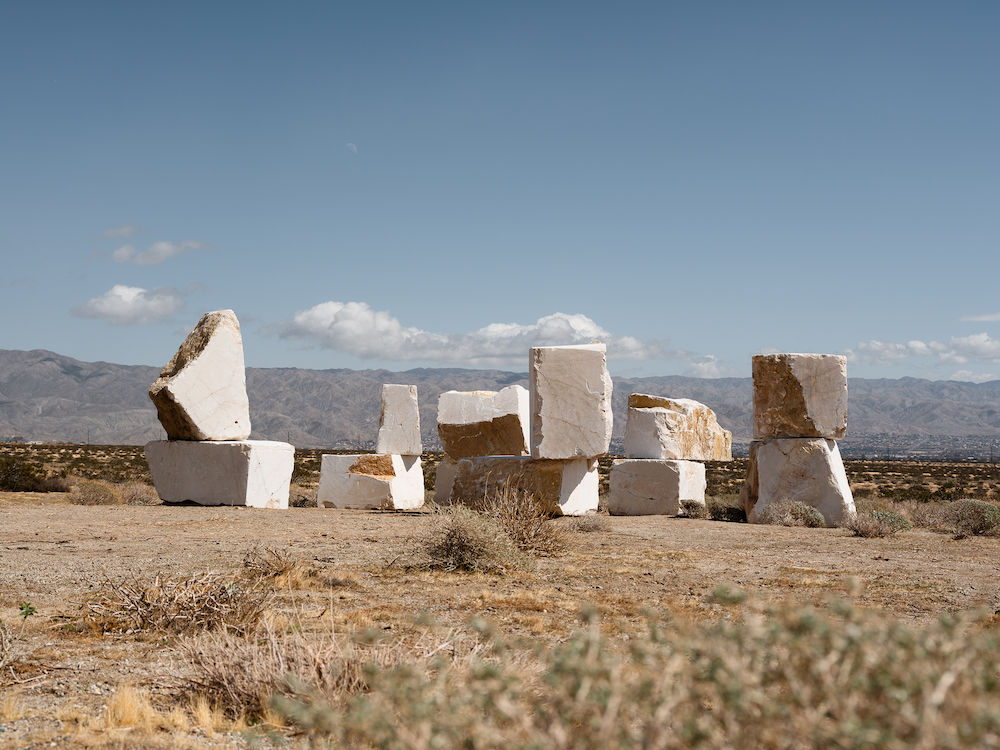
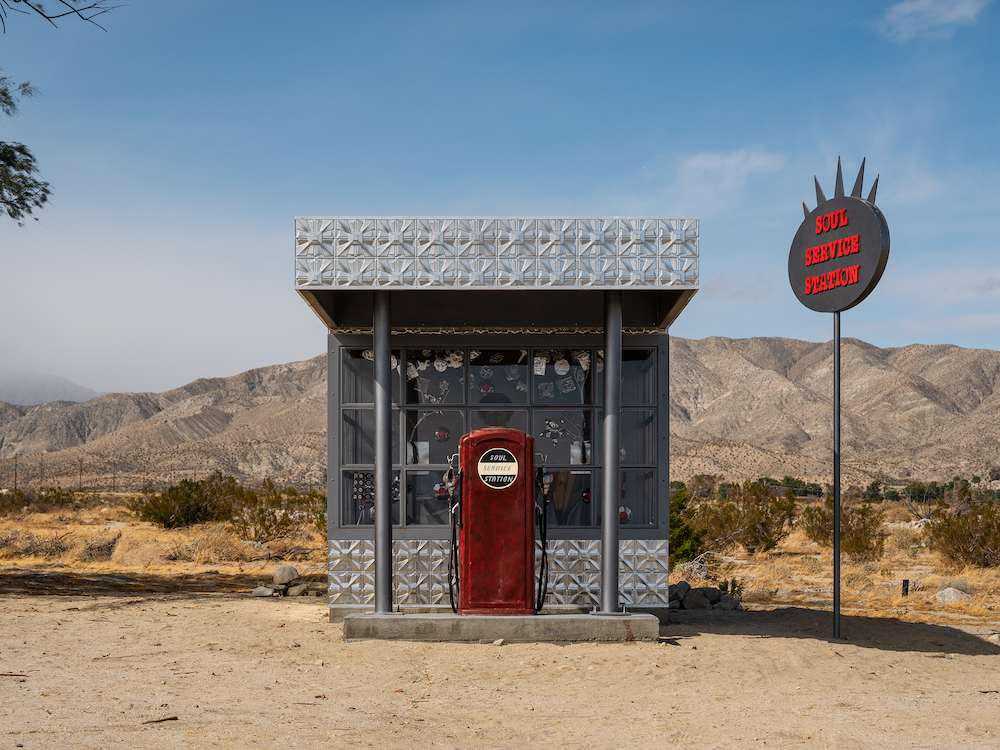
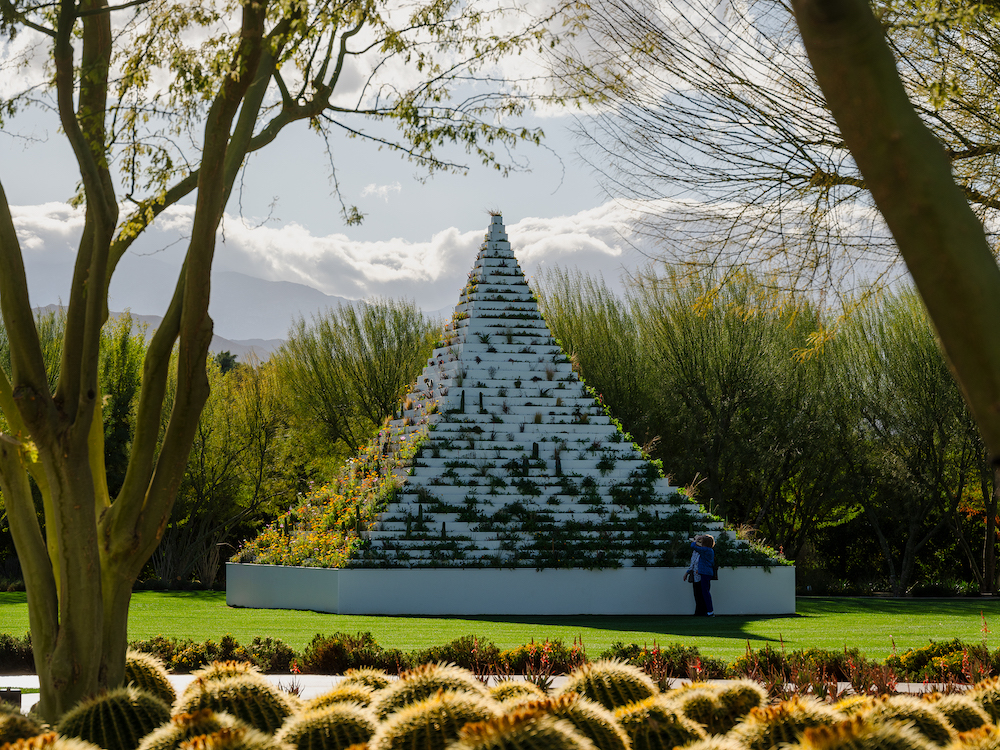
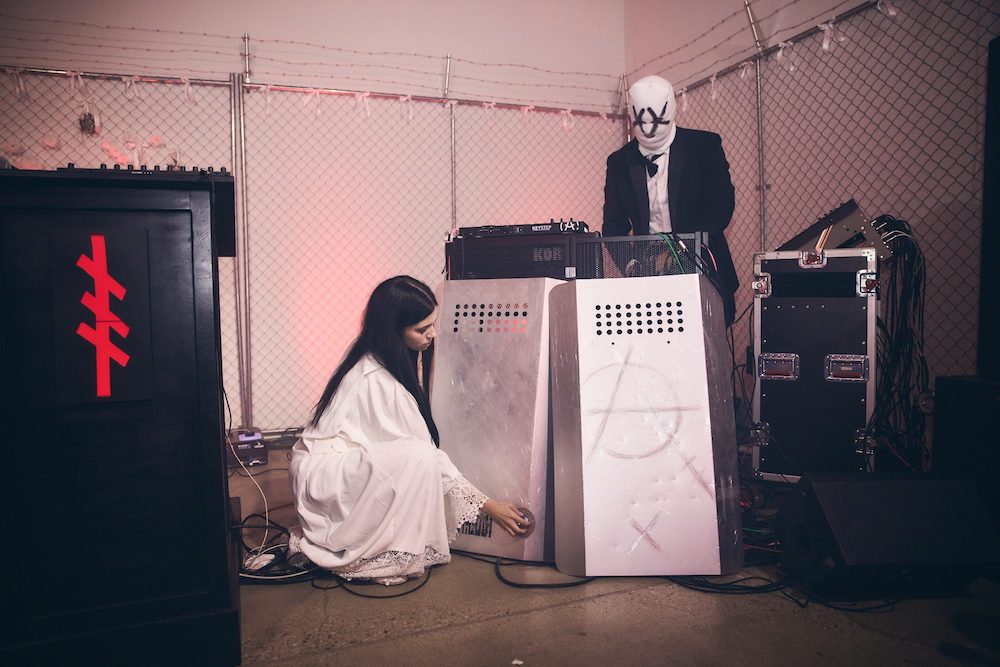
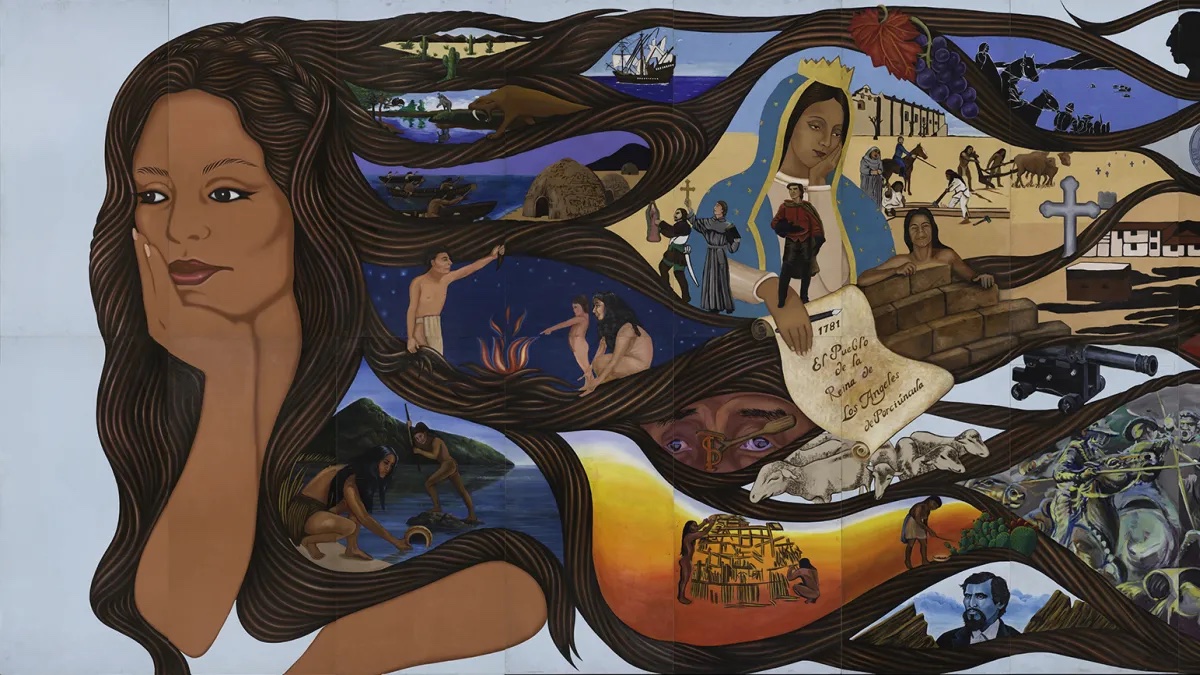
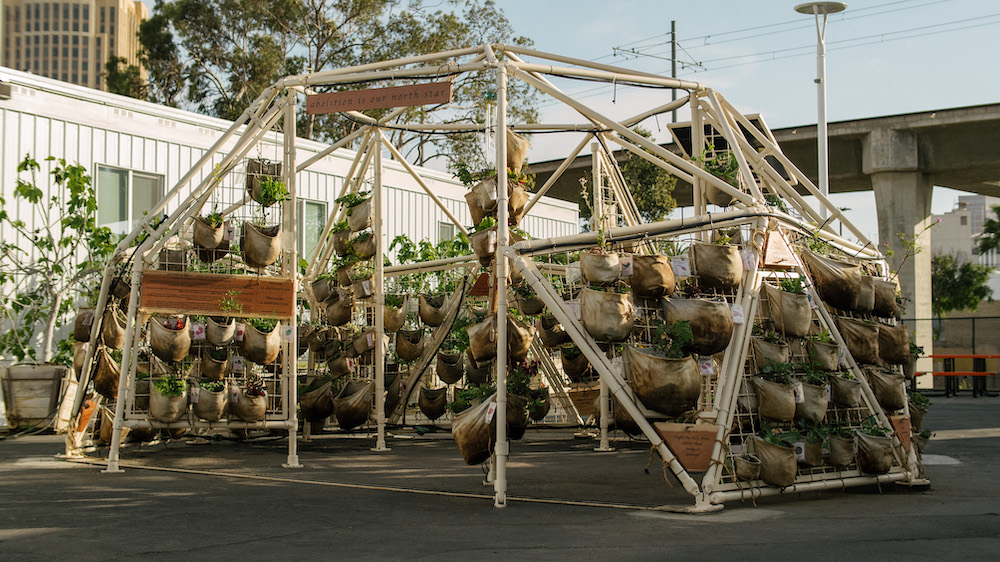
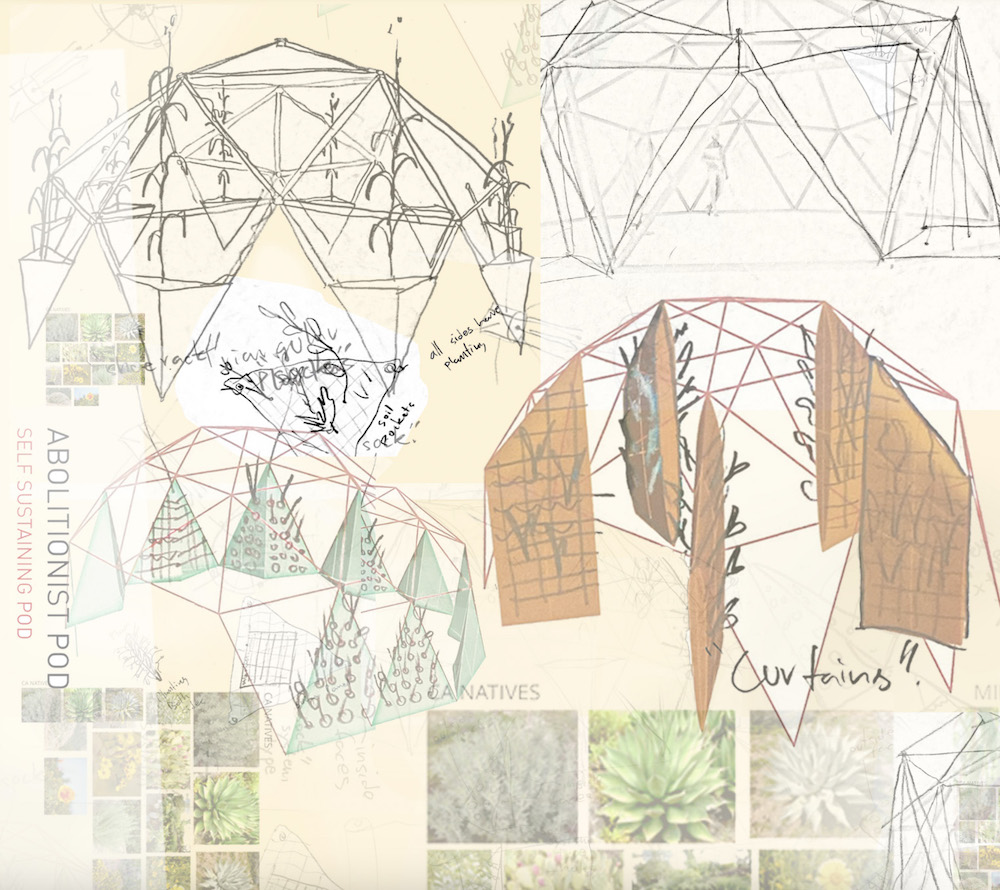
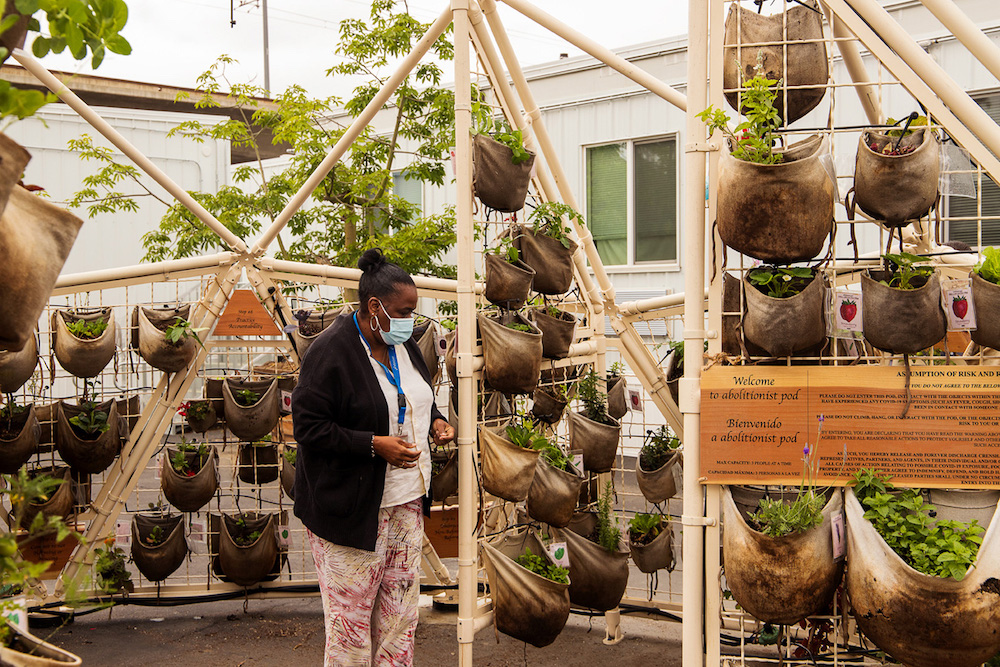
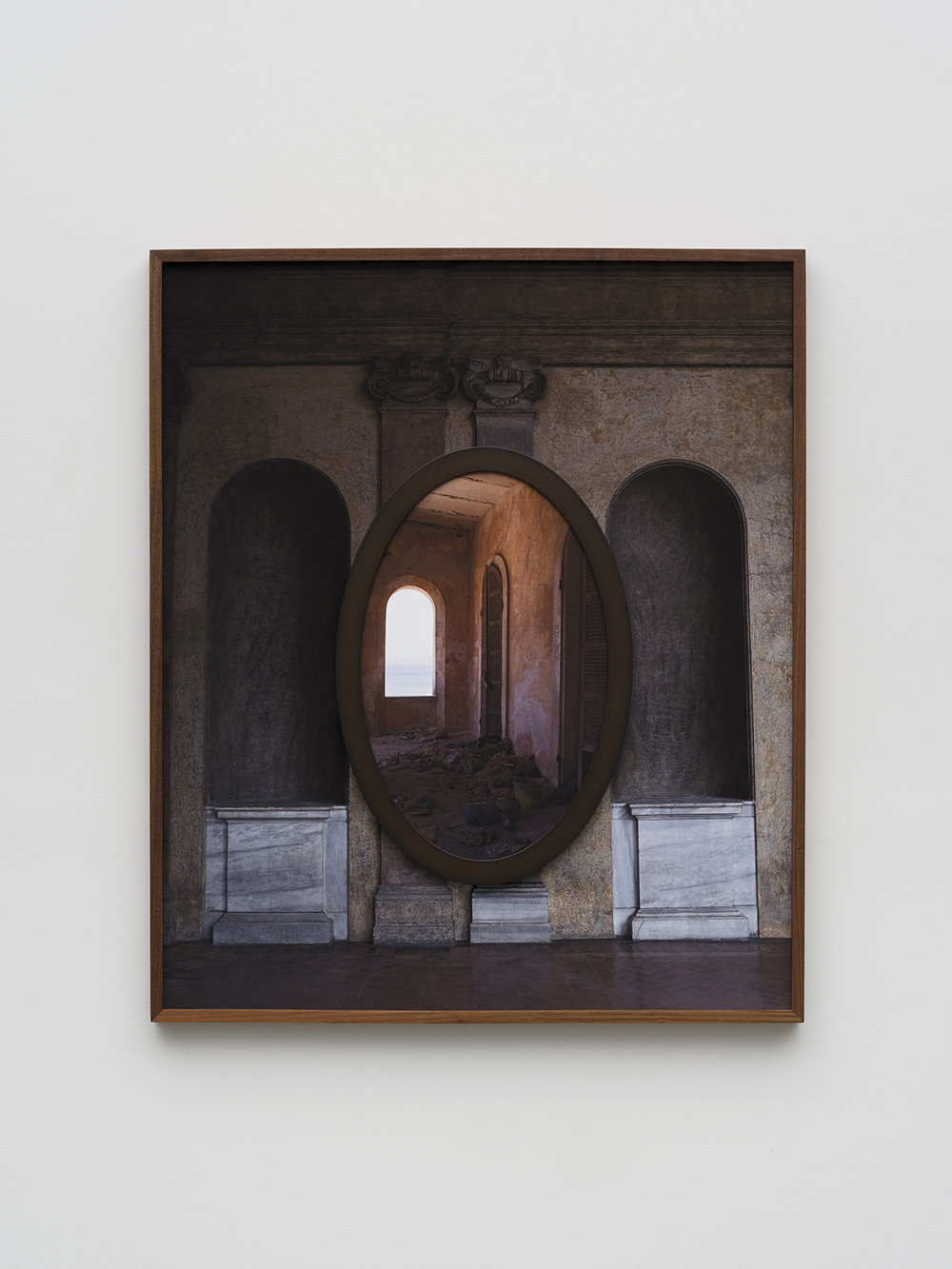
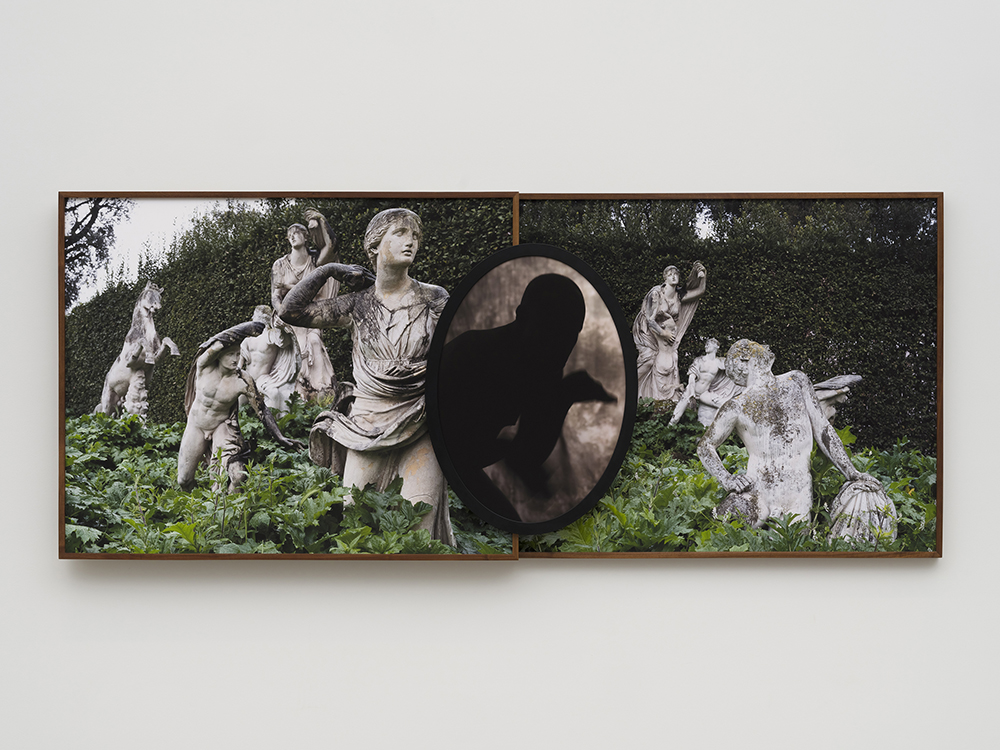
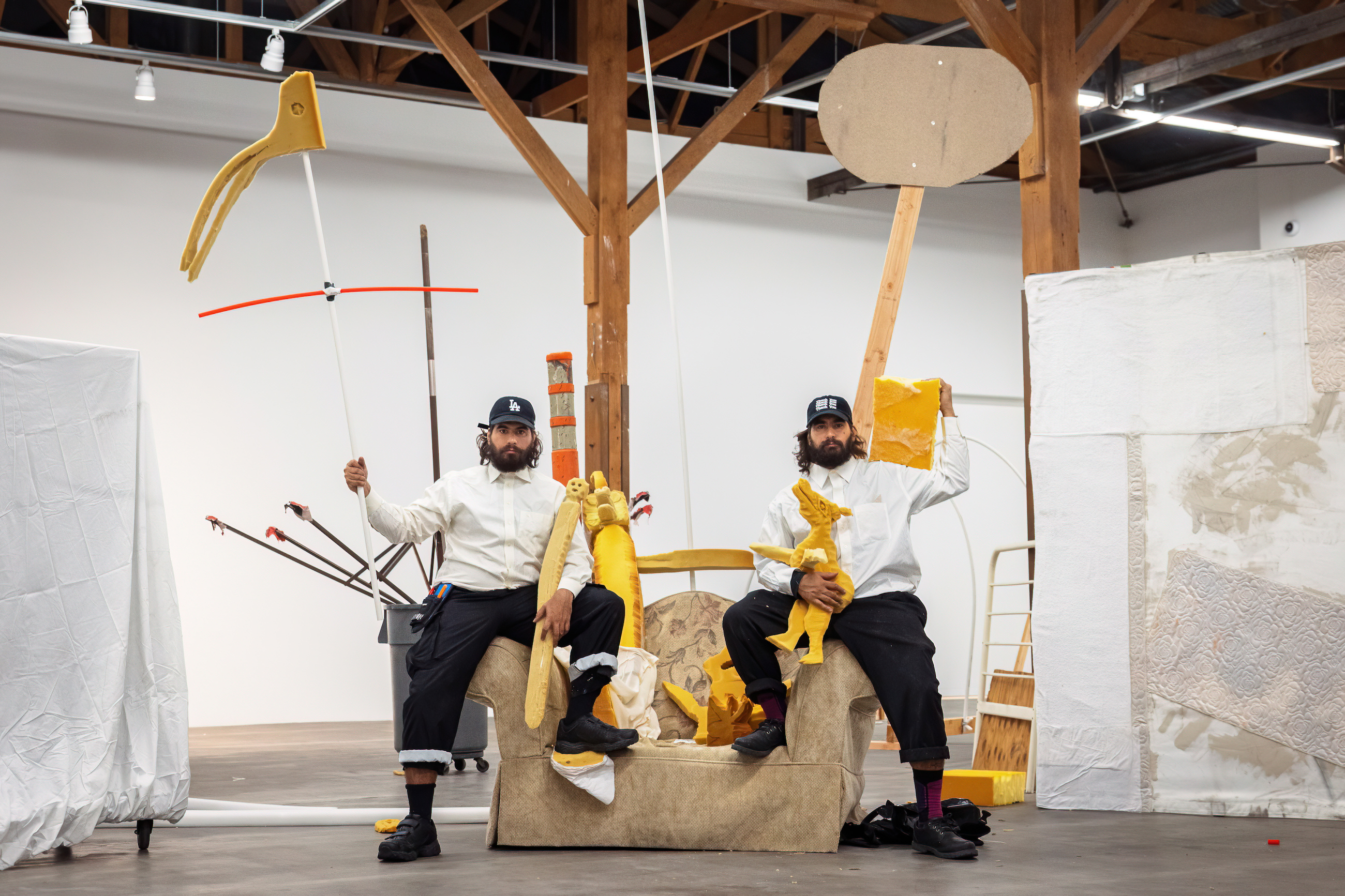

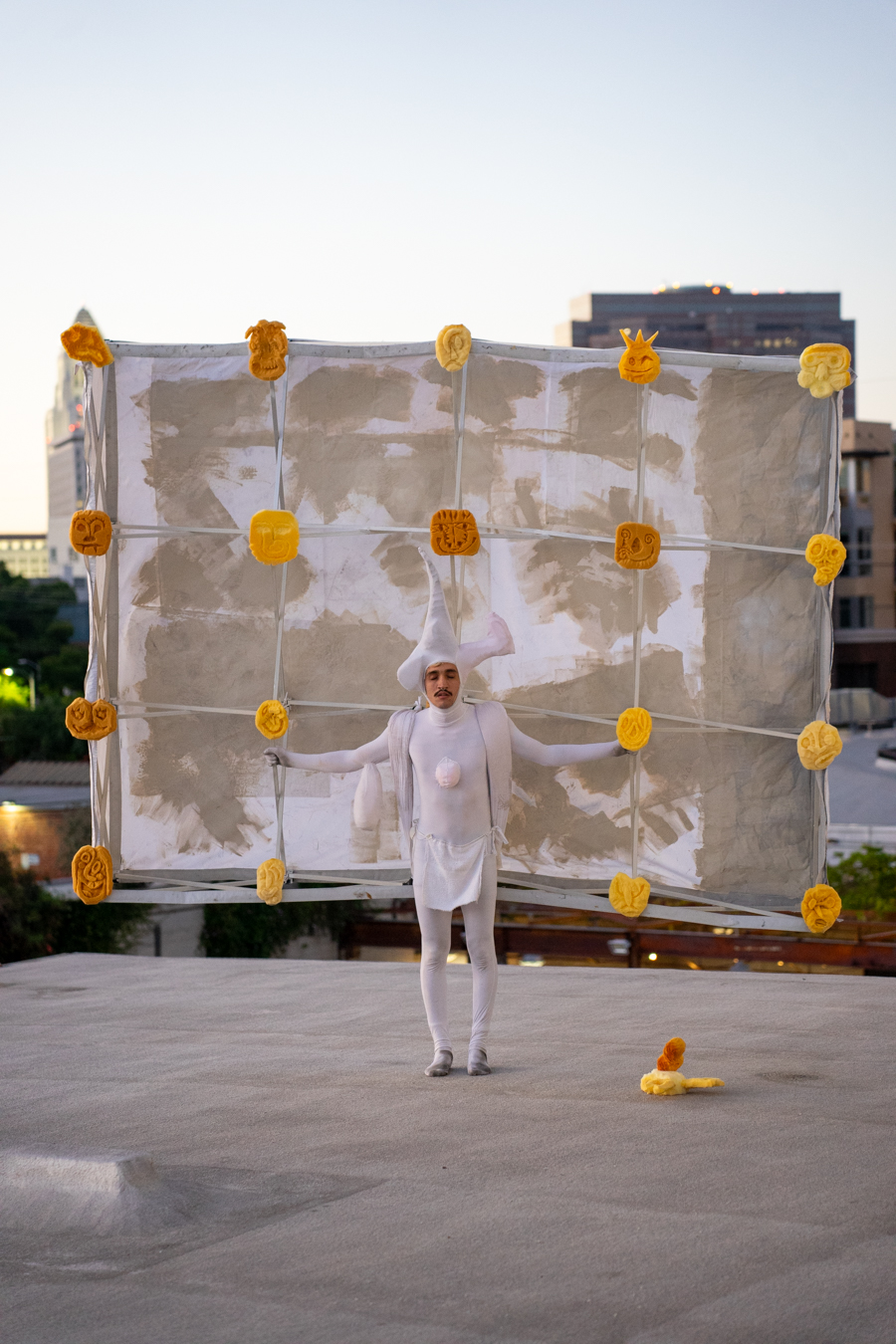
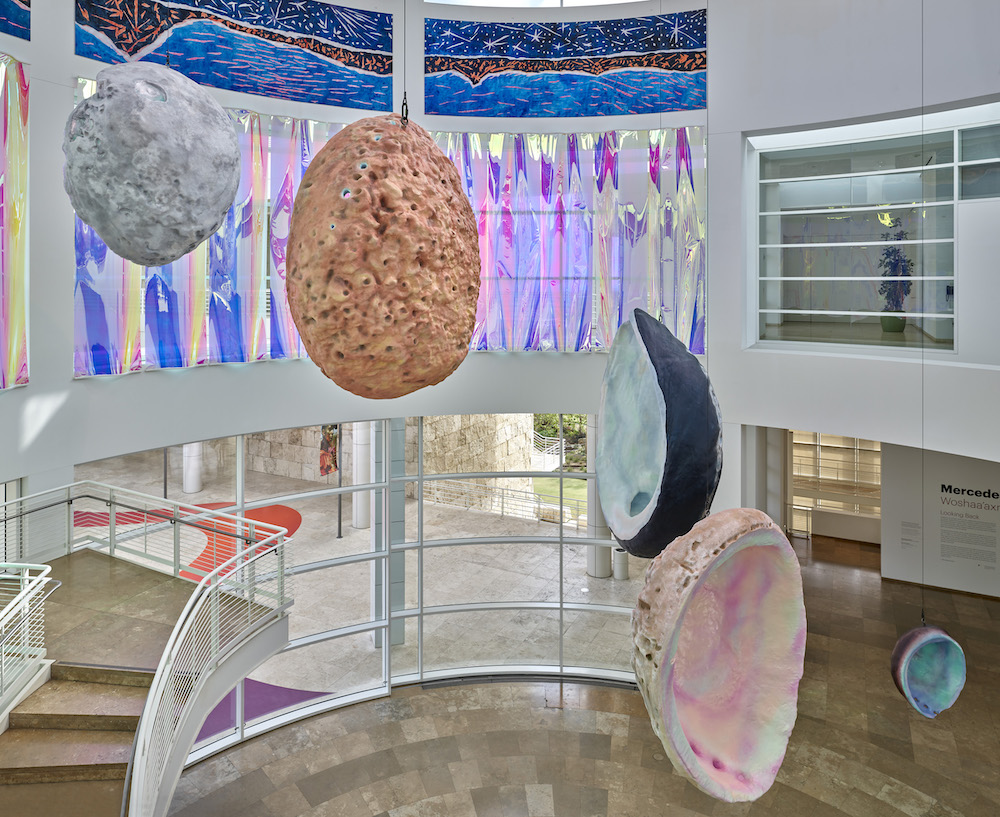
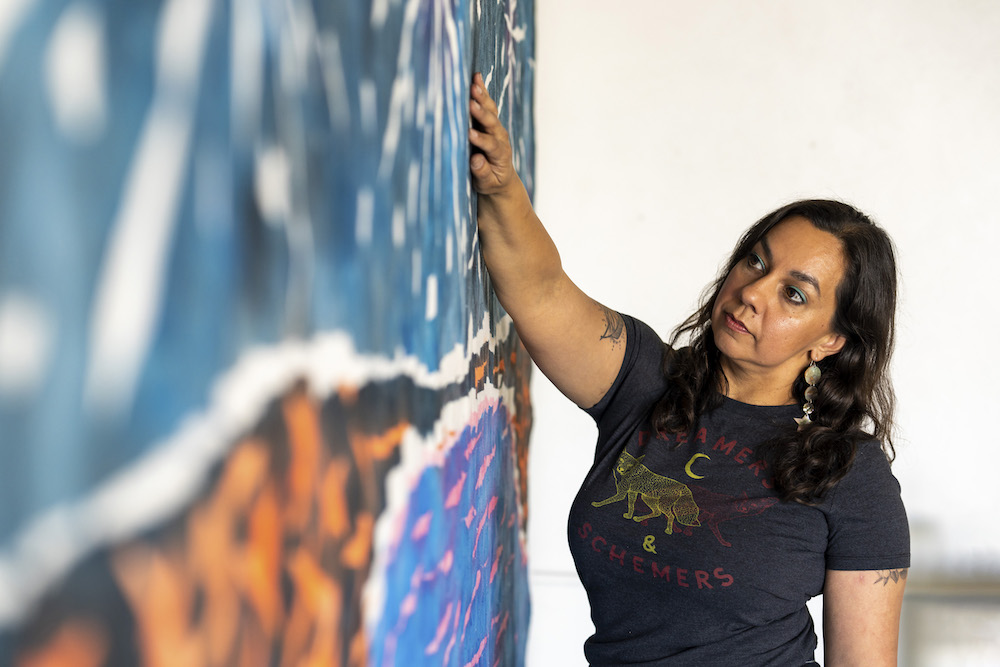

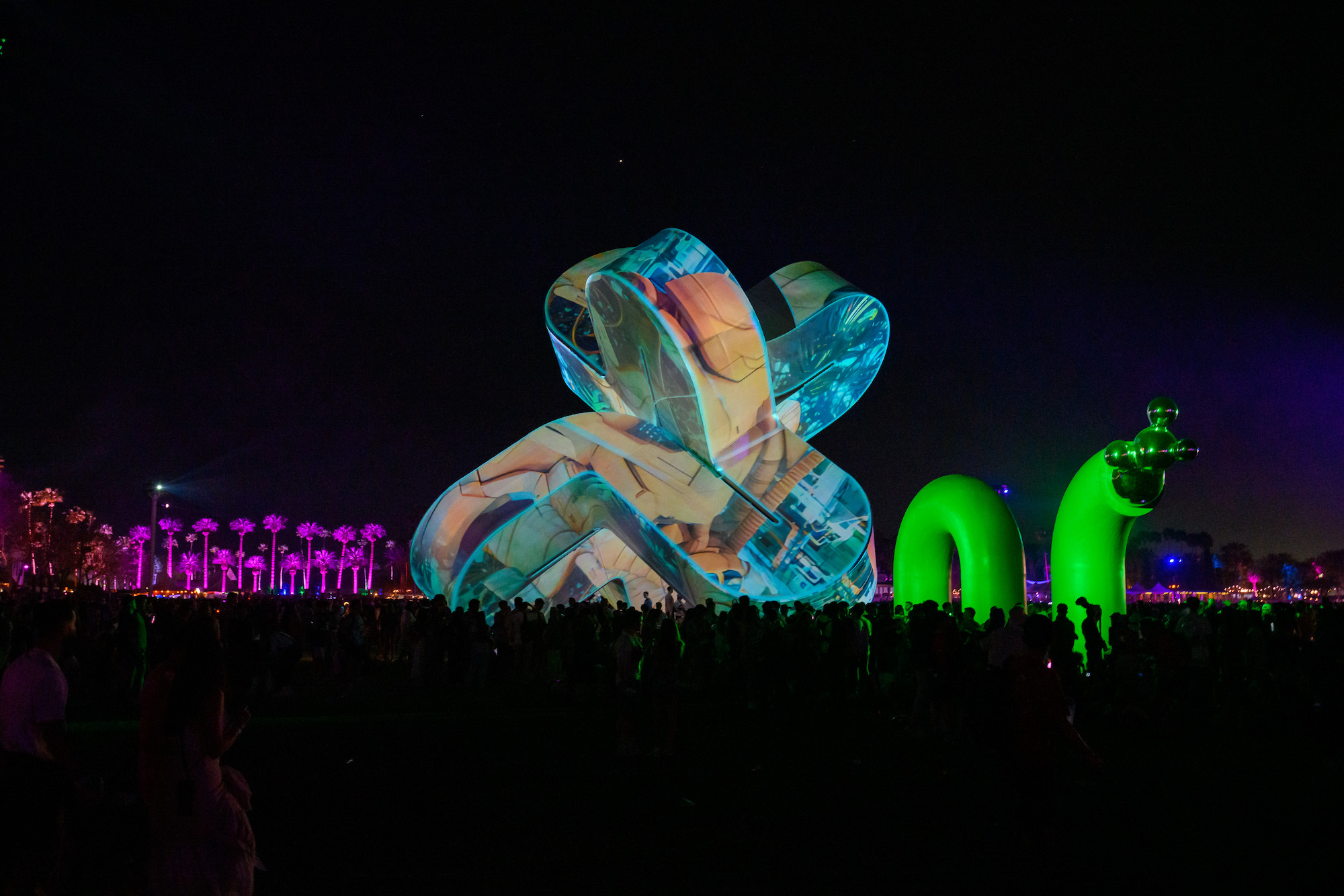
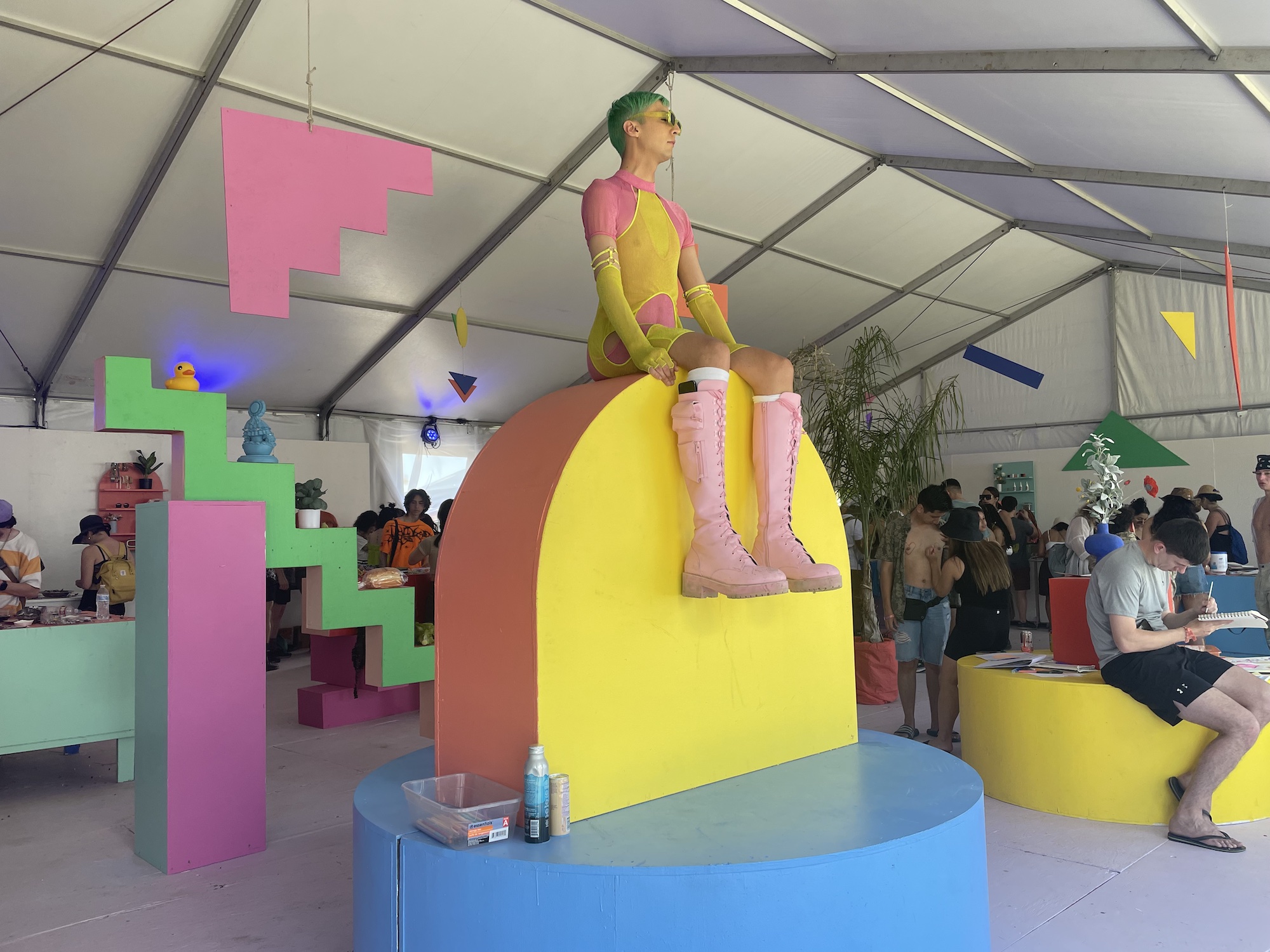
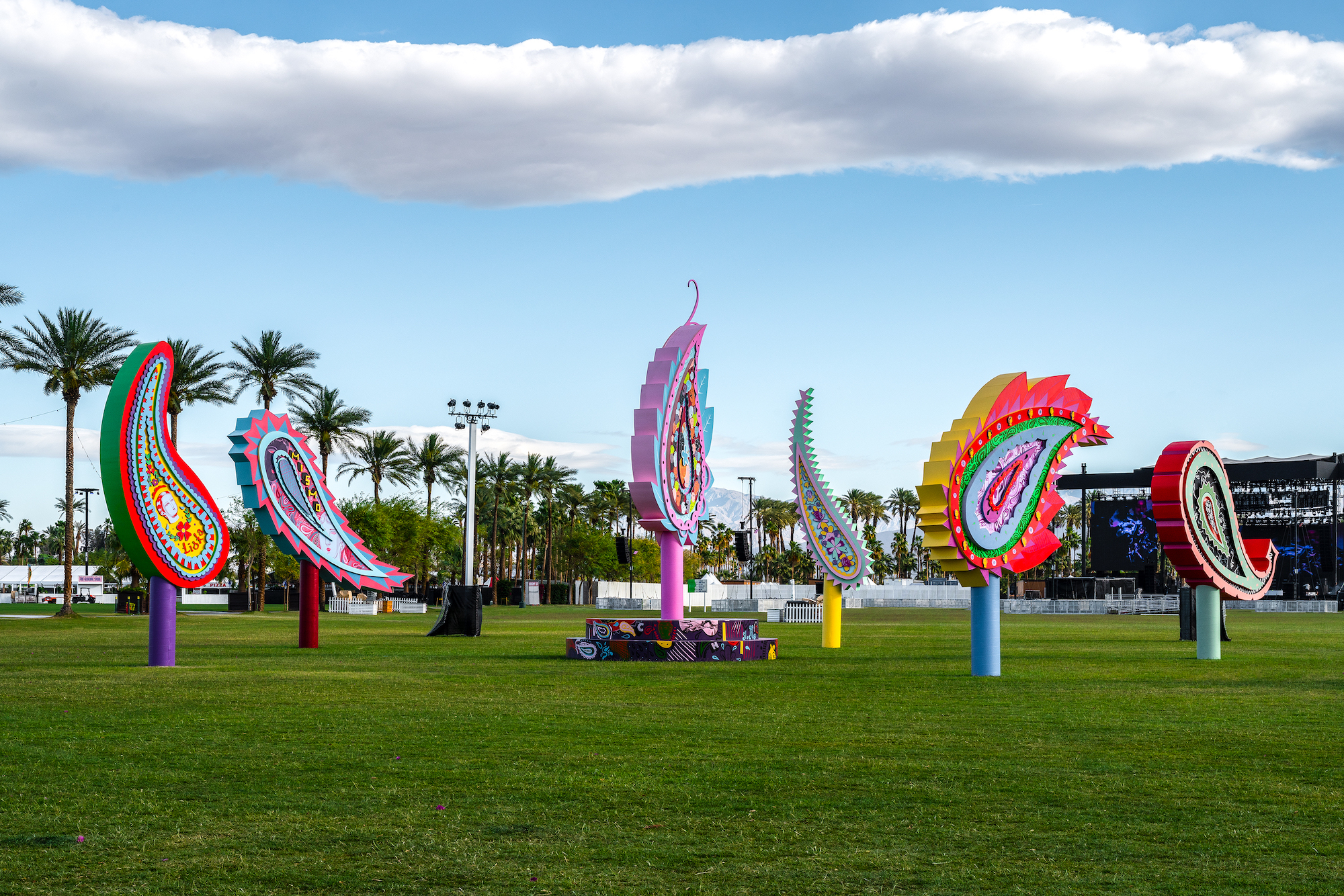
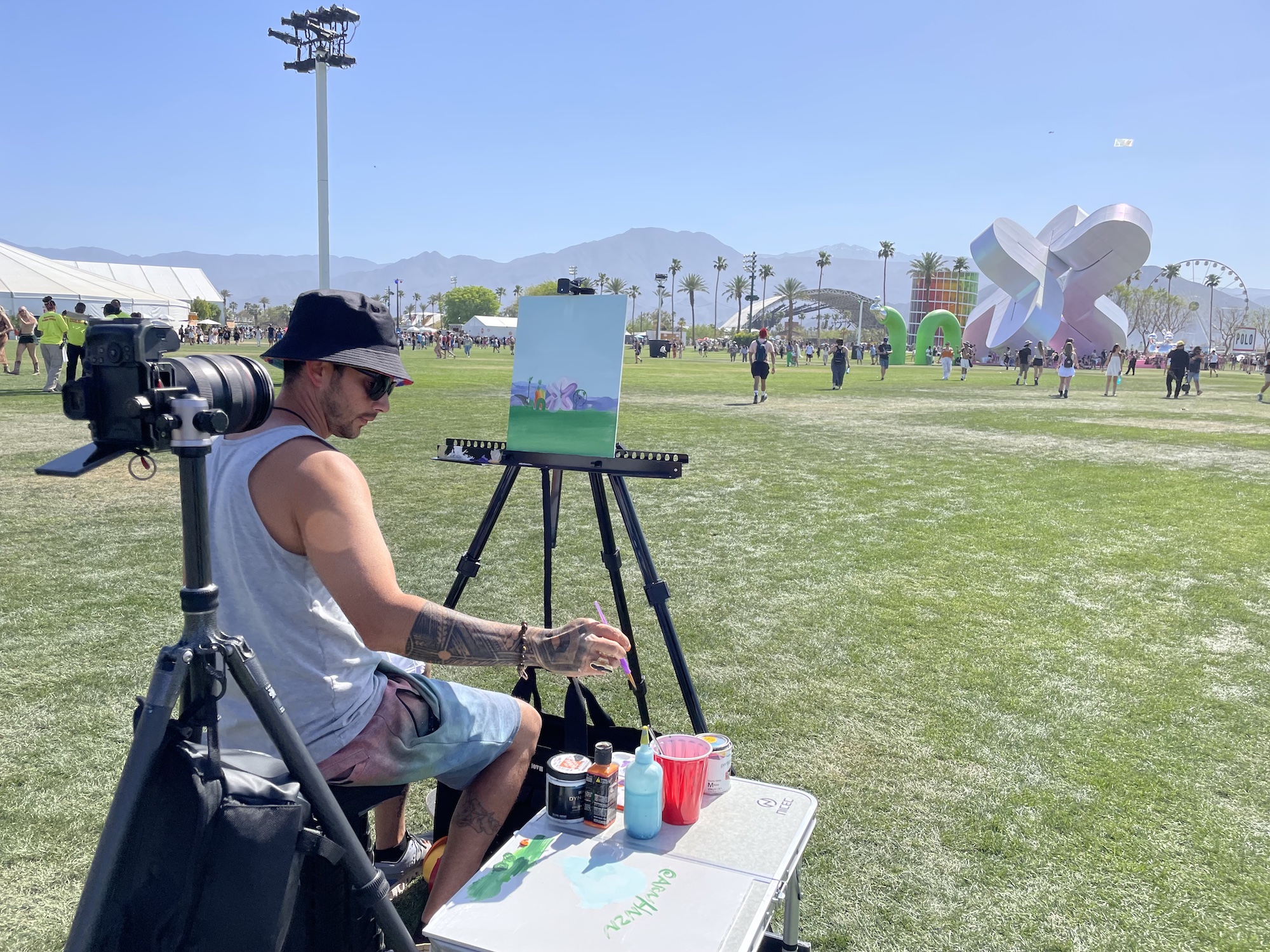
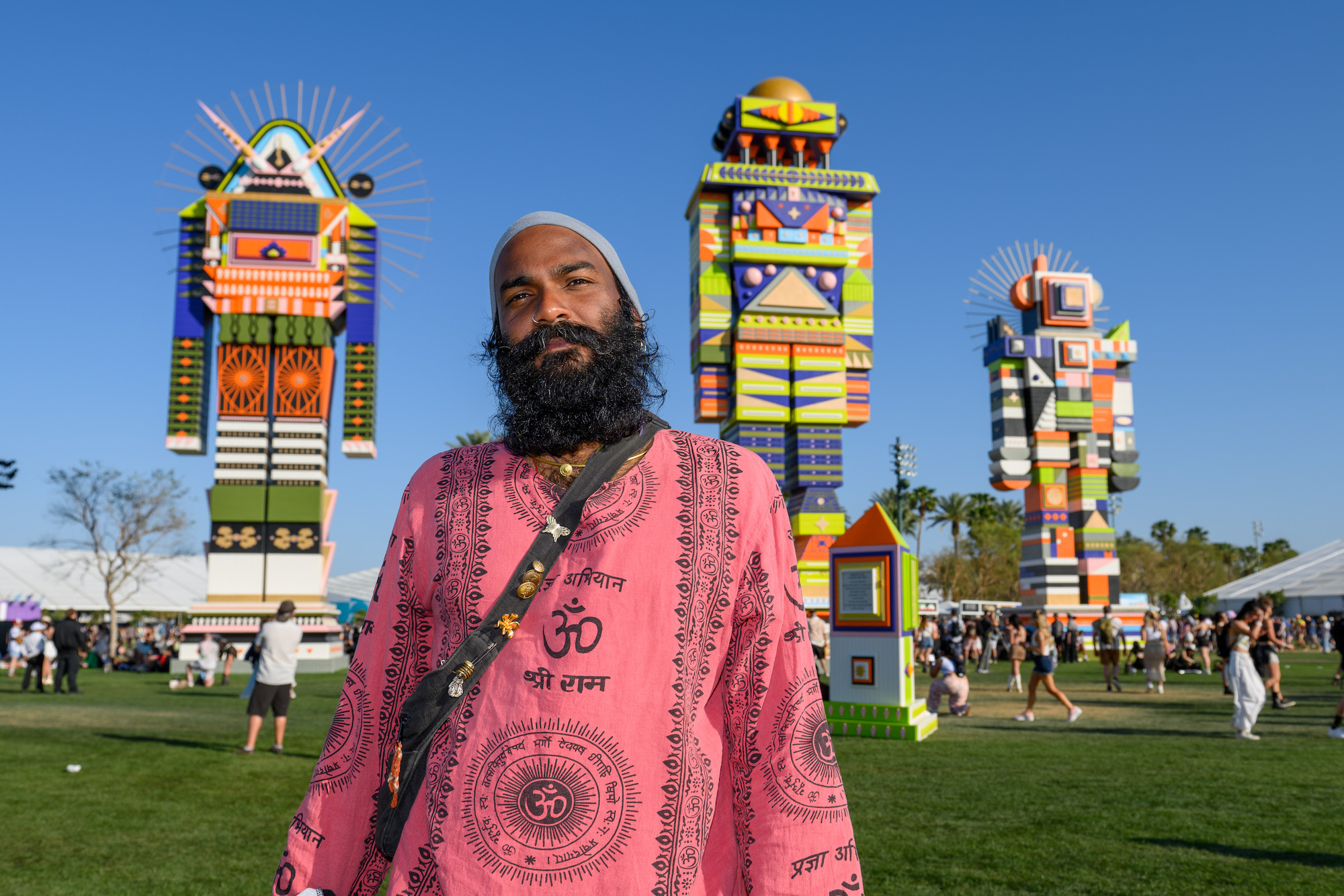
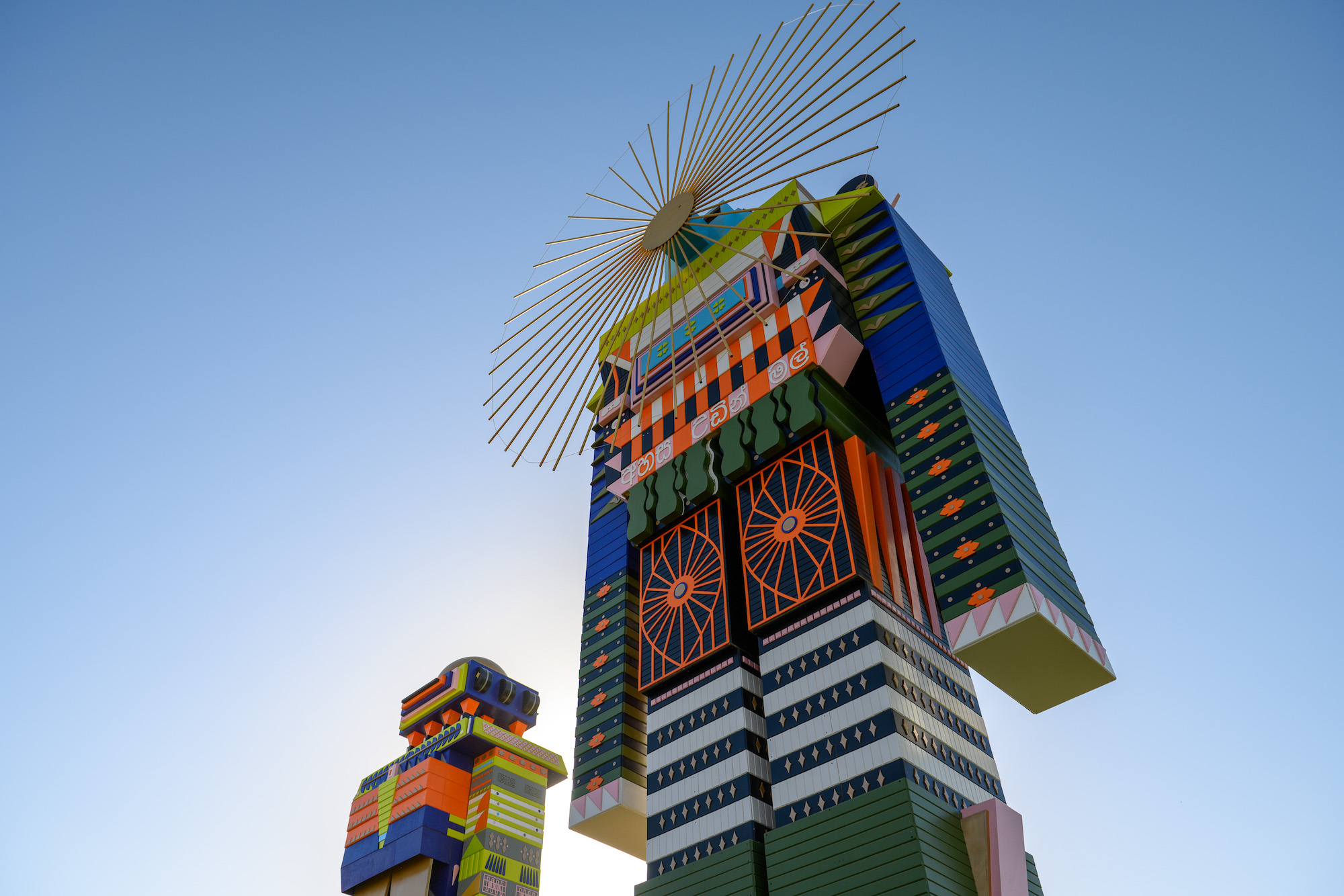
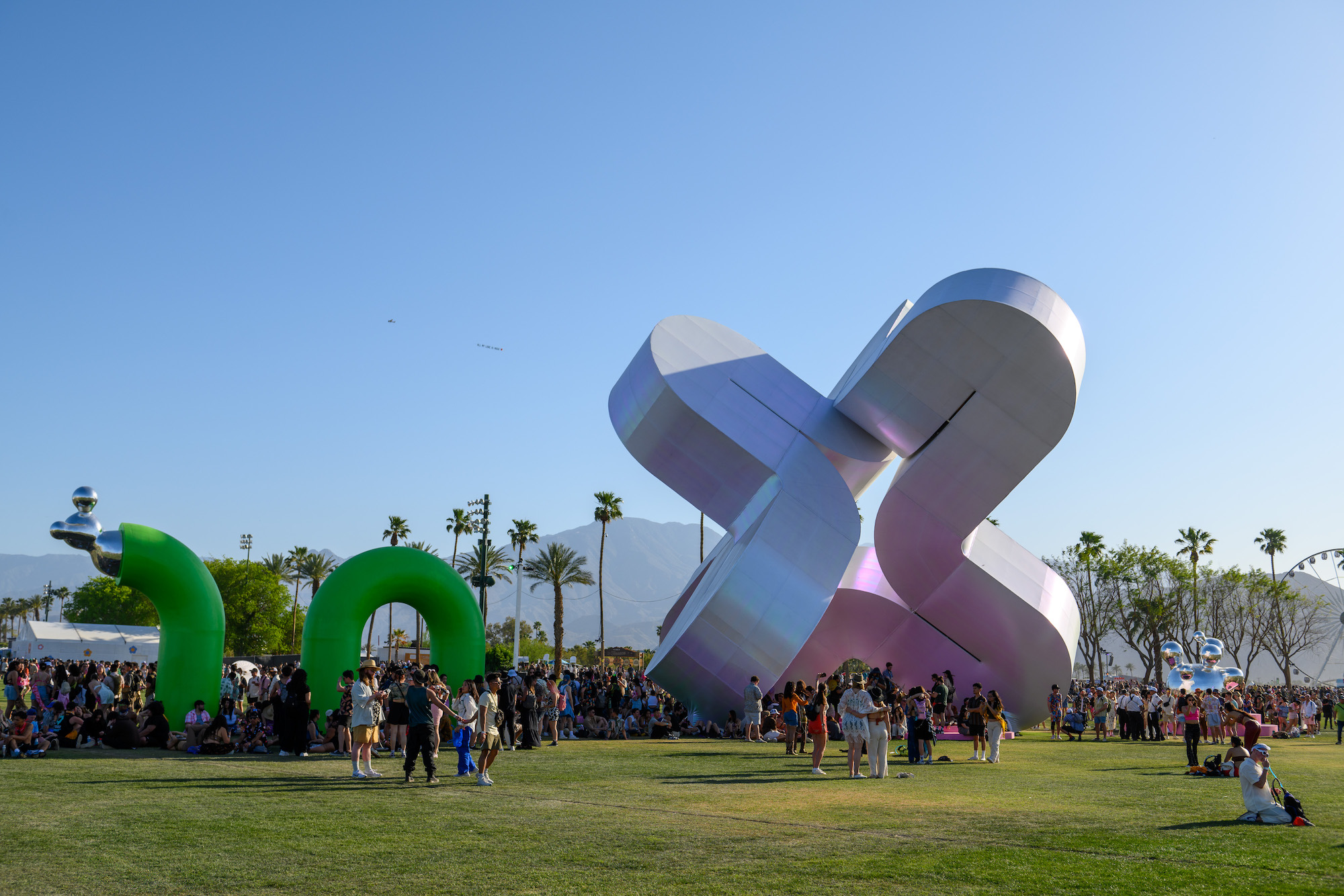
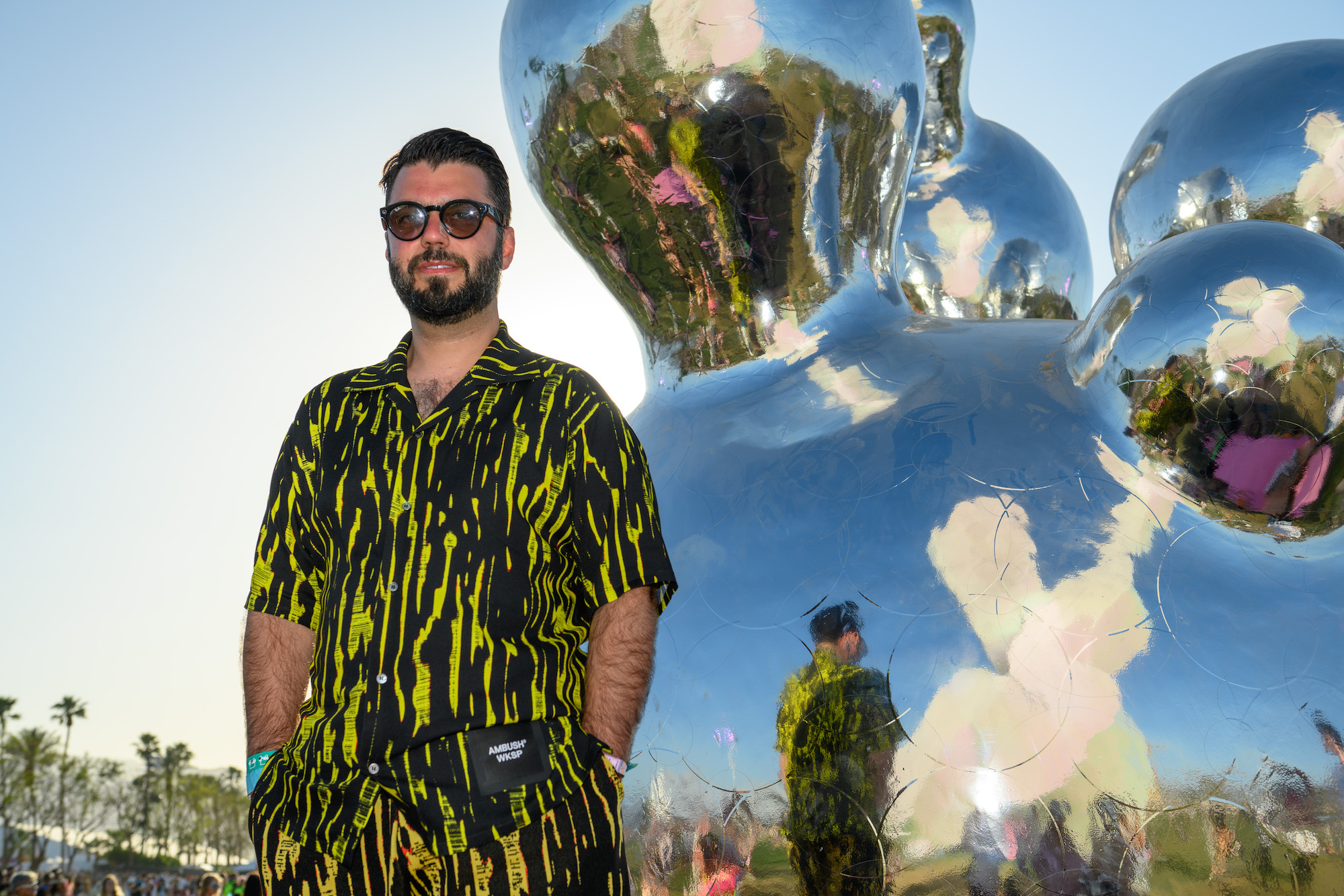 Coachella Valley Music and Arts Festival 2023, Güvenç Özel with his installation “Holoflux,” photo by David Morrison
Coachella Valley Music and Arts Festival 2023, Güvenç Özel with his installation “Holoflux,” photo by David Morrison